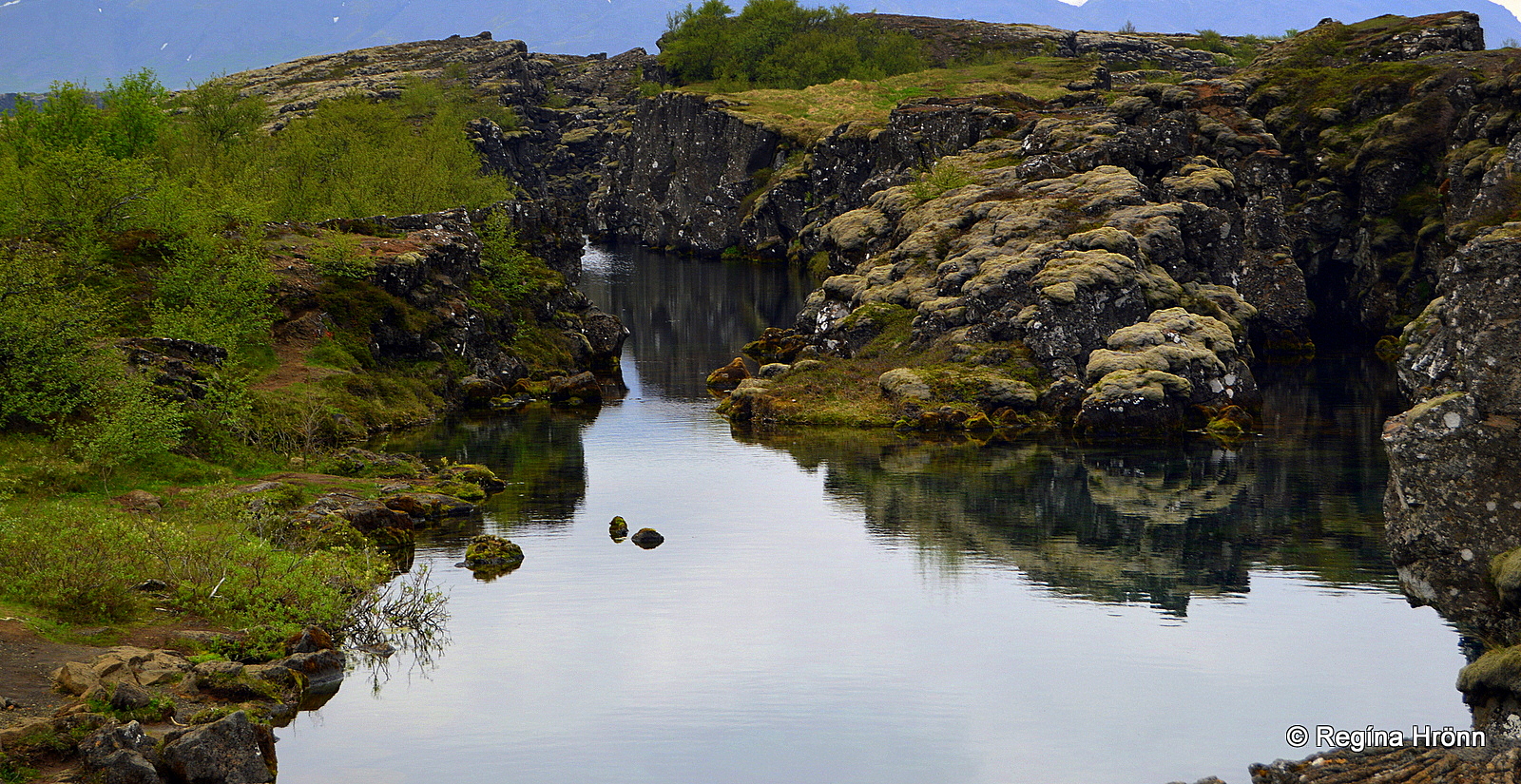
At Þingvellir national park
I have waited forever for a guided tour dedicated to the Vikings and the Sagas, for those of us who want to get to know more about the Vikings and be guided to some of the locations in Iceland, where the Sagas took place.
I joined the Viking and Saga tour so I could introduce it to you and show you what to expect. The Viking and Saga tour will take you on an educational and fun round of some of the main Viking locations in South Iceland.
A part of the tour is dedicated to the jewel in the crown of the Sagas, Njálssaga – the Saga of Njáll.
Þingvellir National Park

Lögberg – the Law Rock at Þingvellir
Our first stop was at Þingvellir national park, where we were guided through the most important and historic location in the Viking history of Iceland. The Vikings founded their first parliament back in 930 here at Þingvellir where they convened for 2 weeks in June every year.
Here the guide will tell you about the Viking parliament – and you will even get a chance to stand in the same location where it is believed that the Law Speaker stood when he cited the laws by heart to the crowd at Þingvellir. It is called Lögberg or Law Rock.
Þingvellir is not only well-known for the Viking parliament, but also for the fact that the tectonic plates are visible above ground creating a very spectacular landscape.
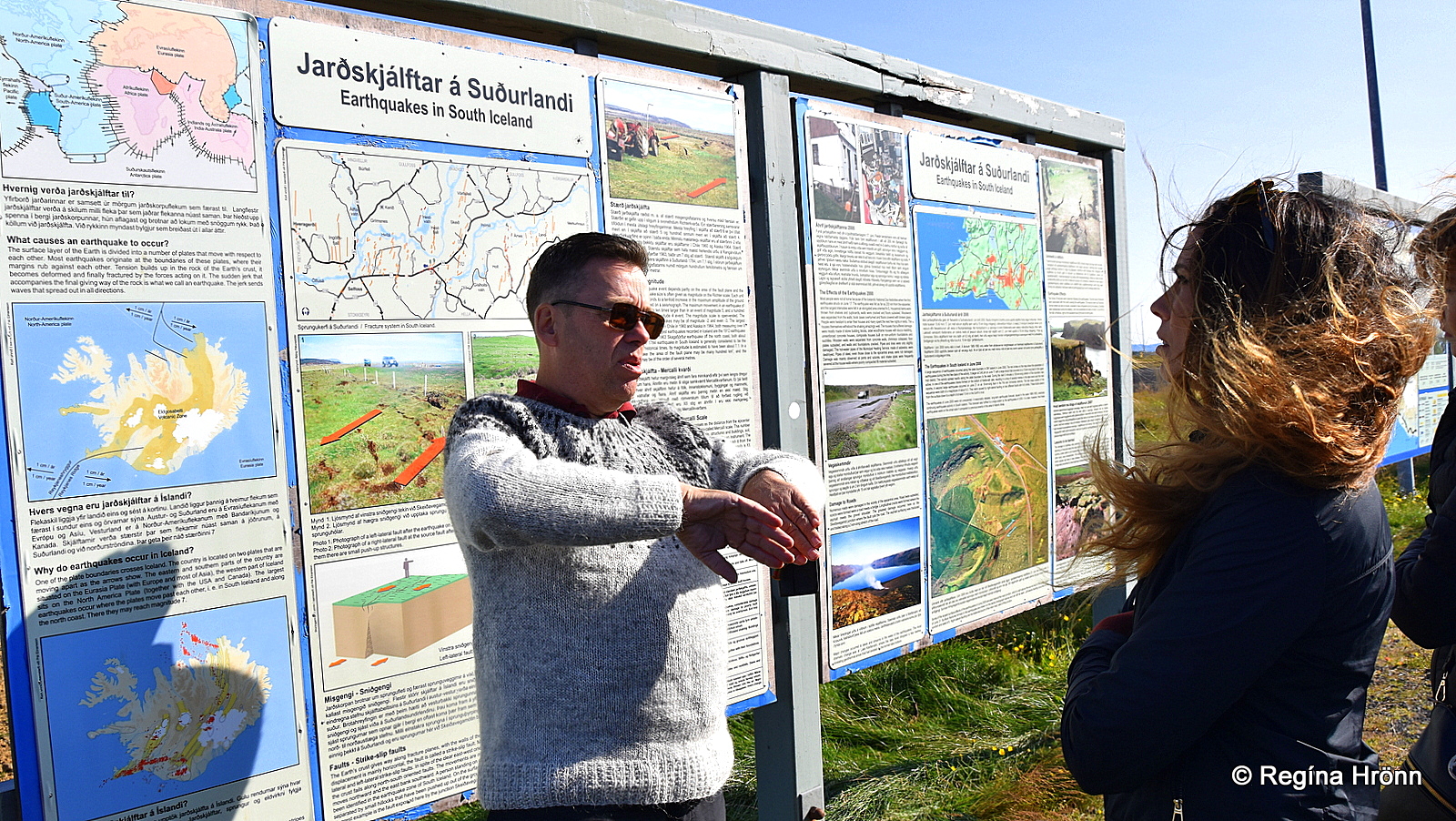
Kjartan, the owner of Glacial Experience, explaining the movements of the tectonic plates to us
Vikings from all over Iceland met up at Þingvellir, and some love affairs started here, f.ex. the love affair of Gunnar and Hallgerður from the Saga of Njáll.
After getting your heart’s fill of the beautiful nature and interesting yet morbid history of Þingvellir, the guide will take you to the beautiful valley of Þjórsárdalur, through which Iceland’s longest river, Þjórsá glacial river runs. Here Vikings resided.
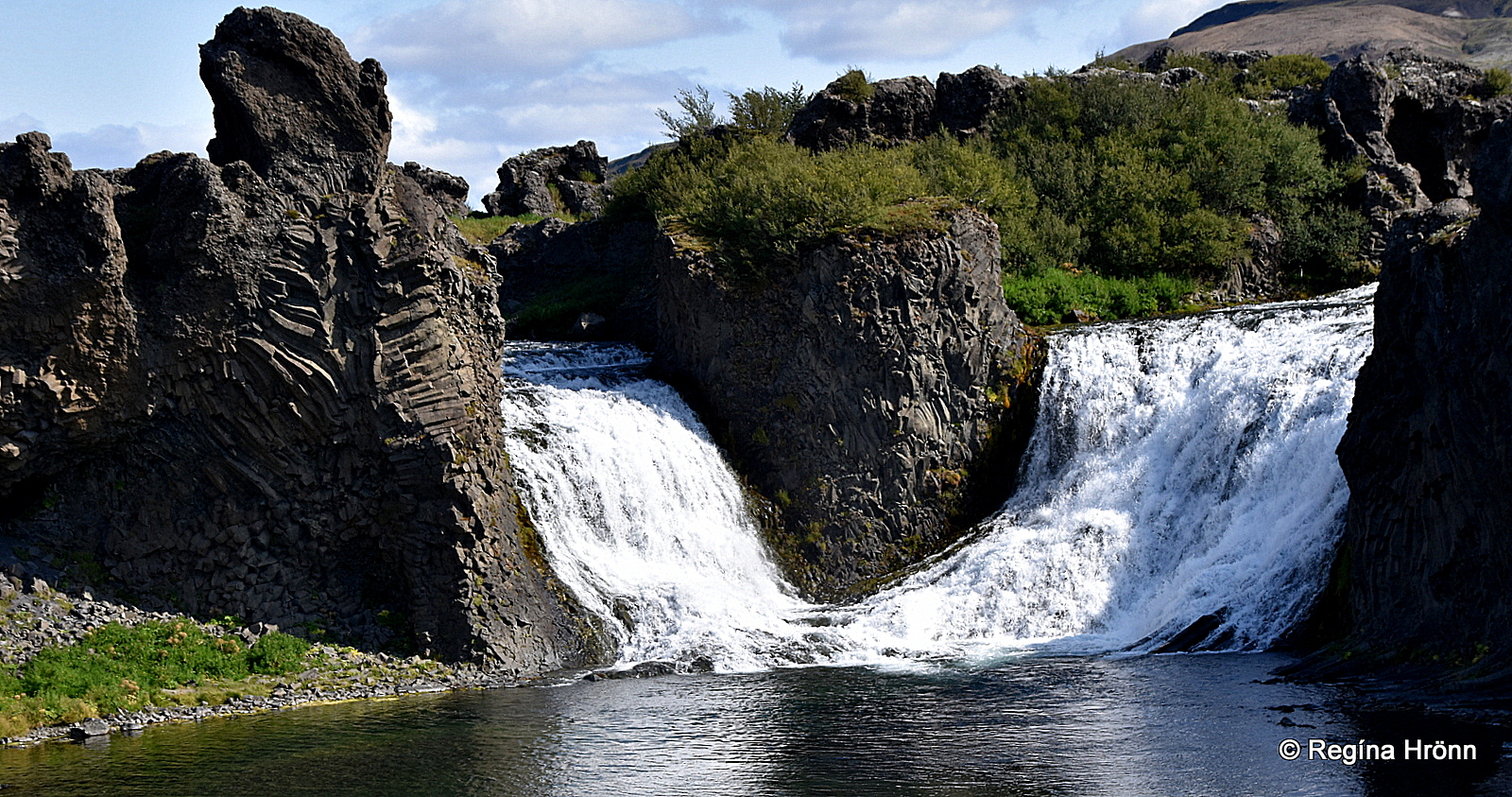
Hjálparfoss waterfall
At the furthest end of this fertile valley, you will visit a hidden waterfall, Hjálparfoss by name, or Help’s Fall. It is a lovely little gem surrounded by the most beautiful basalt formations, one of which reminds me of a bear’s head, which protects this waterfall.
Hjálparfoss – Help’s Fall – is located in Fossá river and above the waterfall, the river splits in two and floats on each side of a big basalt rock, creating this spectacular little waterfall. Fossá river then joins the glacial river Þjórsá.
Þjóðveldisbærinn – Common Wealth Farm
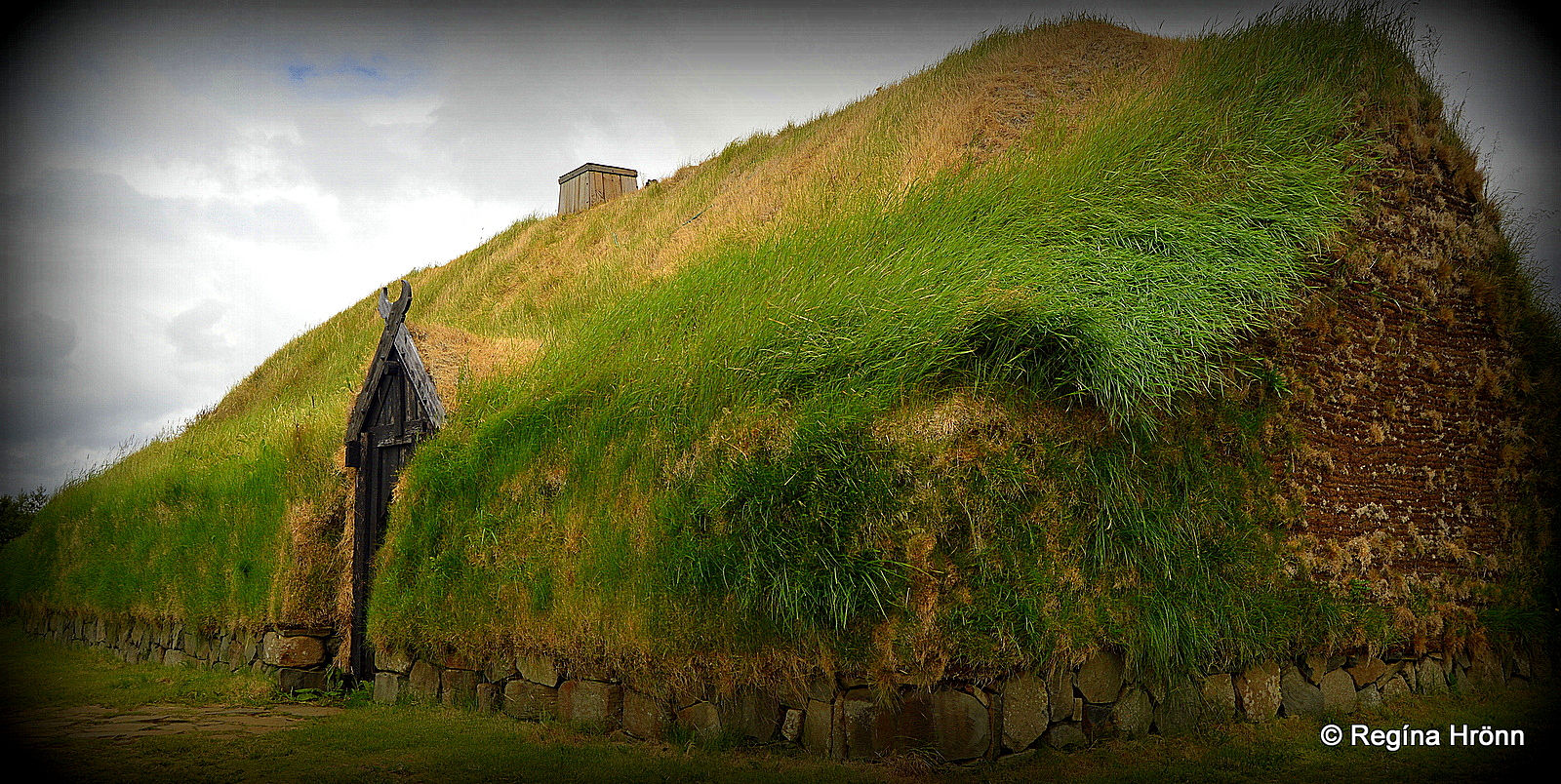
Þjóðveldisbærinn turf longhouse
Even further into Þjórsárdalur valley, just around the corner from Hjálparfoss waterfall, you will get the chance to visit a replica of a Viking longhouse. It is a reconstruction of a Viking longhouse unearthed a bit further north, by the name of Stöng.
If you join the Secret Circle tour you will be able to visit the original ruins of Stöng.
This very authentic looking replica called Þjóðveldisbærinn Stöng or the Common Wealth Farm Stöng was erected back in 1974-1977, at the 1100th anniversary of the Settlement of Iceland.

A replica of a Viking turf church
In the year 2000, a small Viking age chapel was erected next to Þjóðveldisbærinn. Church ruins were discovered at Stöng and this is what experts think it might have looked like.
This part of Þjórsárdalur valley got severely affected when the closeby volcano Hekla erupted for the first time since the Settlement of Iceland. The settlement started around 870, give or take a few years, and Hekla erupted in 1104, resulting in around 22 Viking turf farms and longhouses being buried under layers of pumice.
The volcano Hekla dominates this area, but the Vikings had no idea that they were building their farms in the vicinity of an active volcano. It must have been difficult for them having to move away from this beautiful valley.
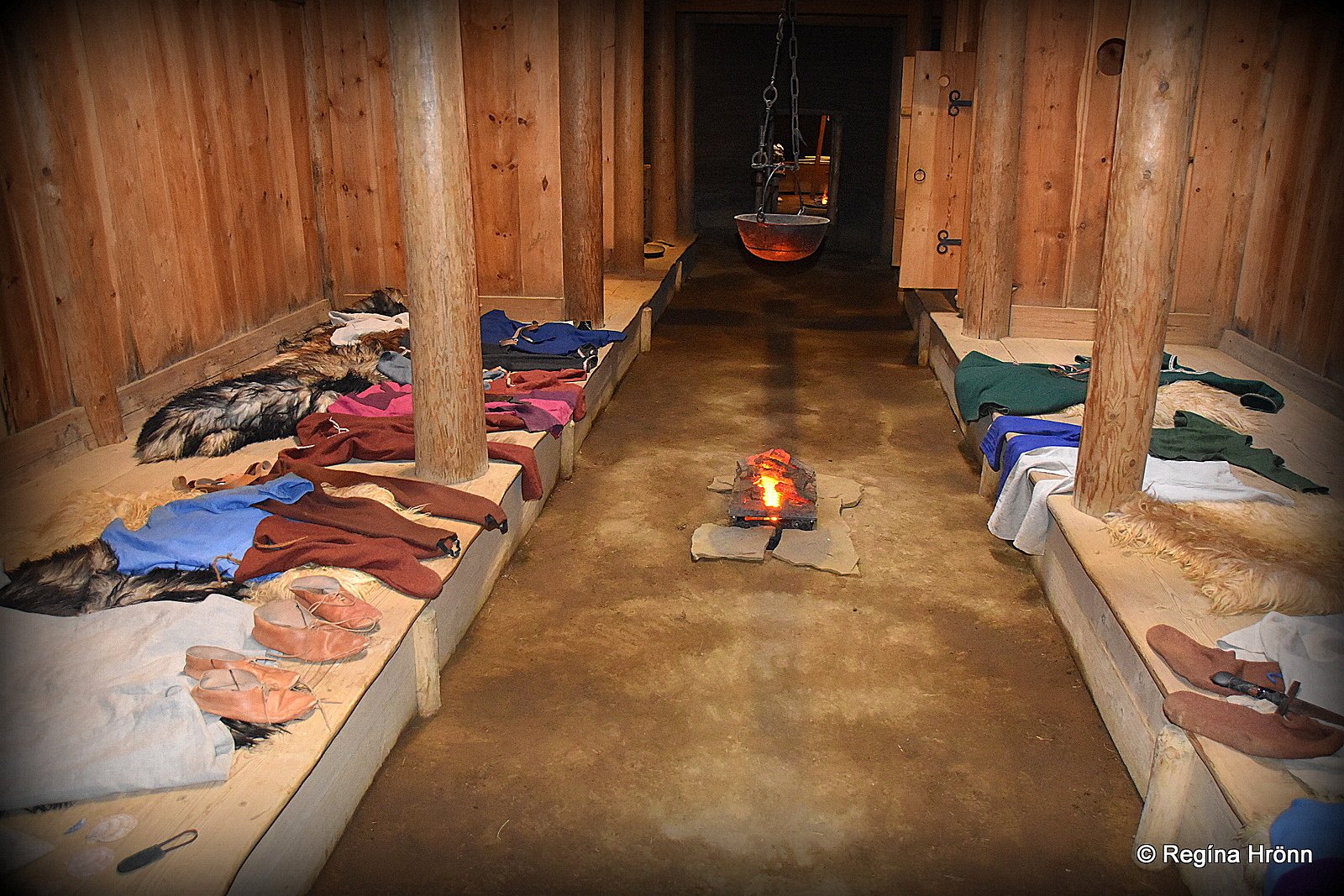
Inside Þjóðveldisbærinn
Þjórsárdalur valley was abandoned, although some Vikings seem to have lived in it until the 13th century. In 1939 during archaeological excavations, many of these Viking farms were discovered, but only the well-preserved ruins of Stöng are on display.
The road leading to the ruins is a rocky gravel road, only suitable for 4×4 jeeps, but Þjóðveldisbærinn – Common Wealth Farm is in a much more convenient location, as it were, with a paved road all the way.
Those of you who have watched the Game of Thrones series will recognize it from one of the episodes where the villagers were killed by the Wildlings and only a little boy’s life was spared.
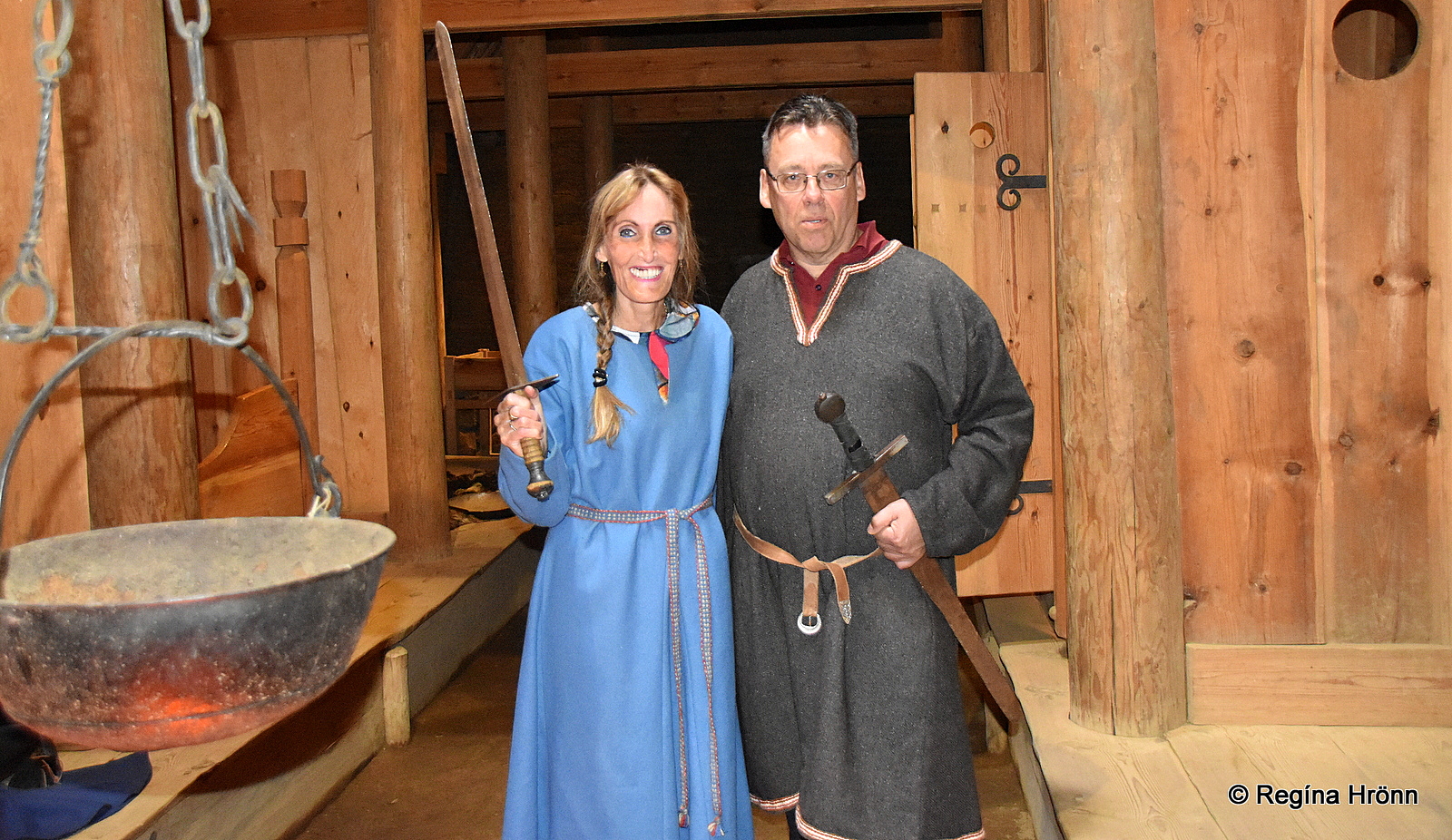
We got to dress up in Viking clothes – Kjartan and I were trying to look a bit fierce in the photo – totally in vain 🙂
Step inside Þjóðveldisbærinn for a peek into Viking history and see how the Vikings lived in longhouses with a longfire in the middle. Here you can try on Viking clothes and carry a sword or a knife – it is a great photo opportunity.
This is a unique opportunity to see how the Vikings lived way back when in Þjórsárdalur valley. You will find another such longhouse on a smaller scale though in West-Iceland at Eiríksstaðir in Haukadalur valley.
Admittance to Þjóðveldisbærinn is included in the price of the tour.
The Icelandic Sagas
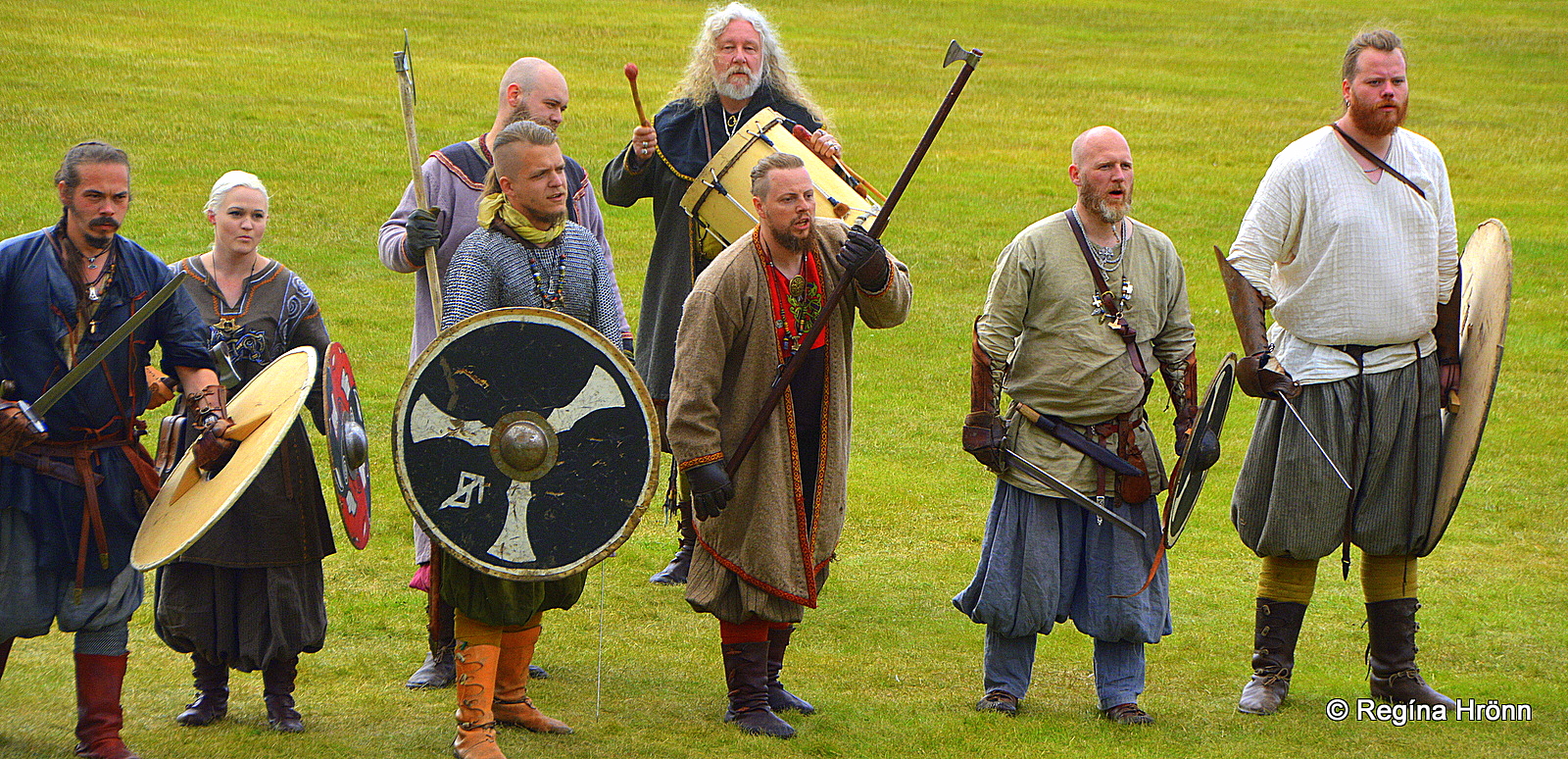
Vikings from the Viking club Rimmugýgur at the annual Viking festival in Iceland
The Icelandic Sagas are family sagas, written in the 13th-14 century. They give us a great insight into the life of the Vikings, who settled Iceland and their descendants back in the 9th-11th century.
The Sagas give us insight into the lives of the sons and daughters of the Viking settlers and show us what the 2nd and 3rd generations of Vikings in Iceland were up to.
These Sagas are actual stories about love and betrayal amongst the Vikings, the code of honour and revenge. And this endless lust for power that seems to follow humankind.
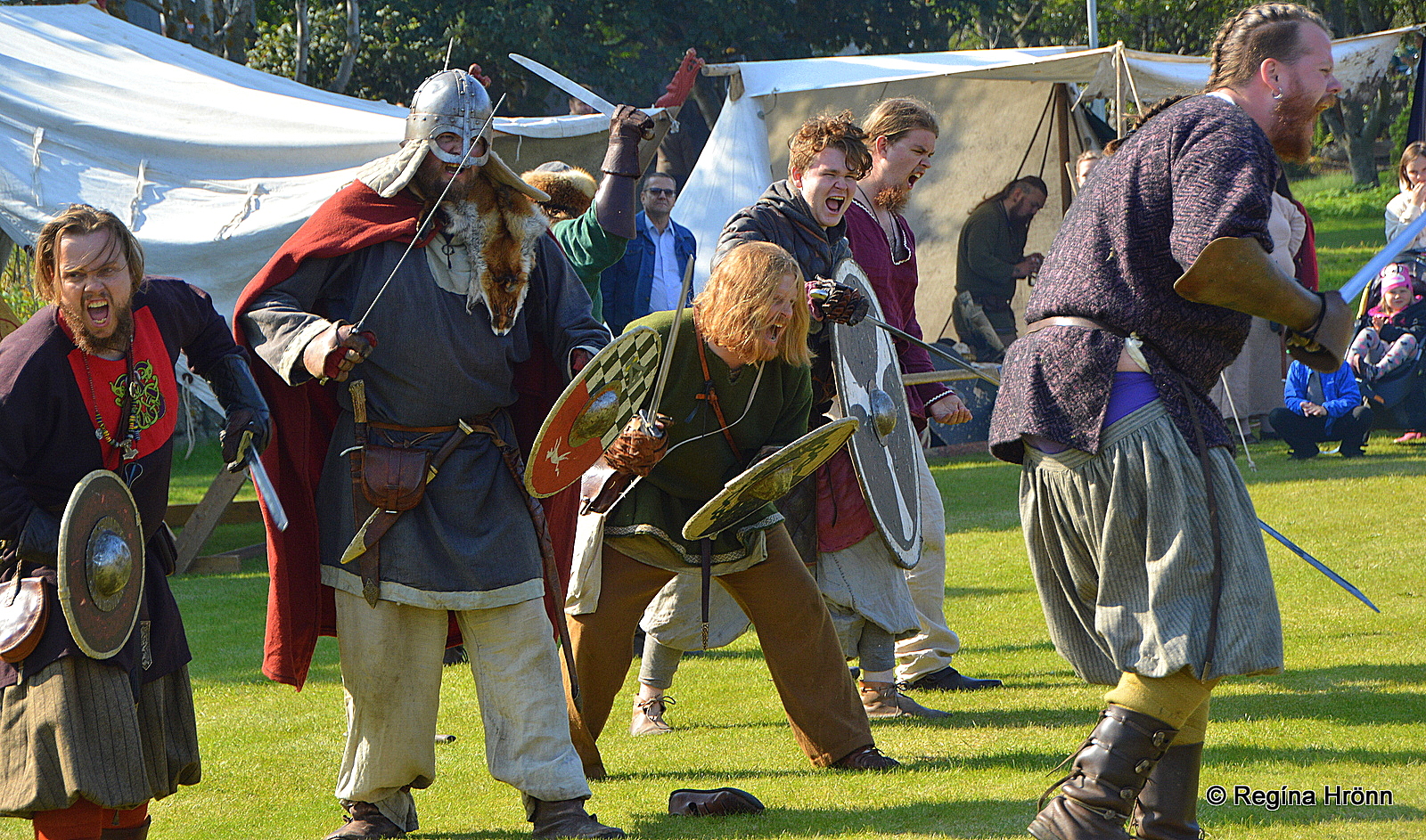
Vikings from the Viking club Rimmugýgur at Culture Night in Reykjavík
Blood feuds were a big part of the Sagas; one Viking avenged his family or blood-brother and then another one avenged his family and so on.
Before the Sagas were written down the storytellers told the same stories again and again for the legacies to be carried on. The stories were finally written down on calfskin and became the Sagas as we know them today.

An old manuscript at the Culture House in Reykjavík
Many of the Sagas, unfortunately, were lost, and they might even have been eaten during a famine in Iceland.
And around 12 of them were lost (not counting bits and pieces of Sagas) in a great fire in Copenhagen back in 1728, but fortunately, many of them were saved.
So now there are 40 Sagas left. It is such a great loss that some of these Sagas were lost, as they are pure gems.
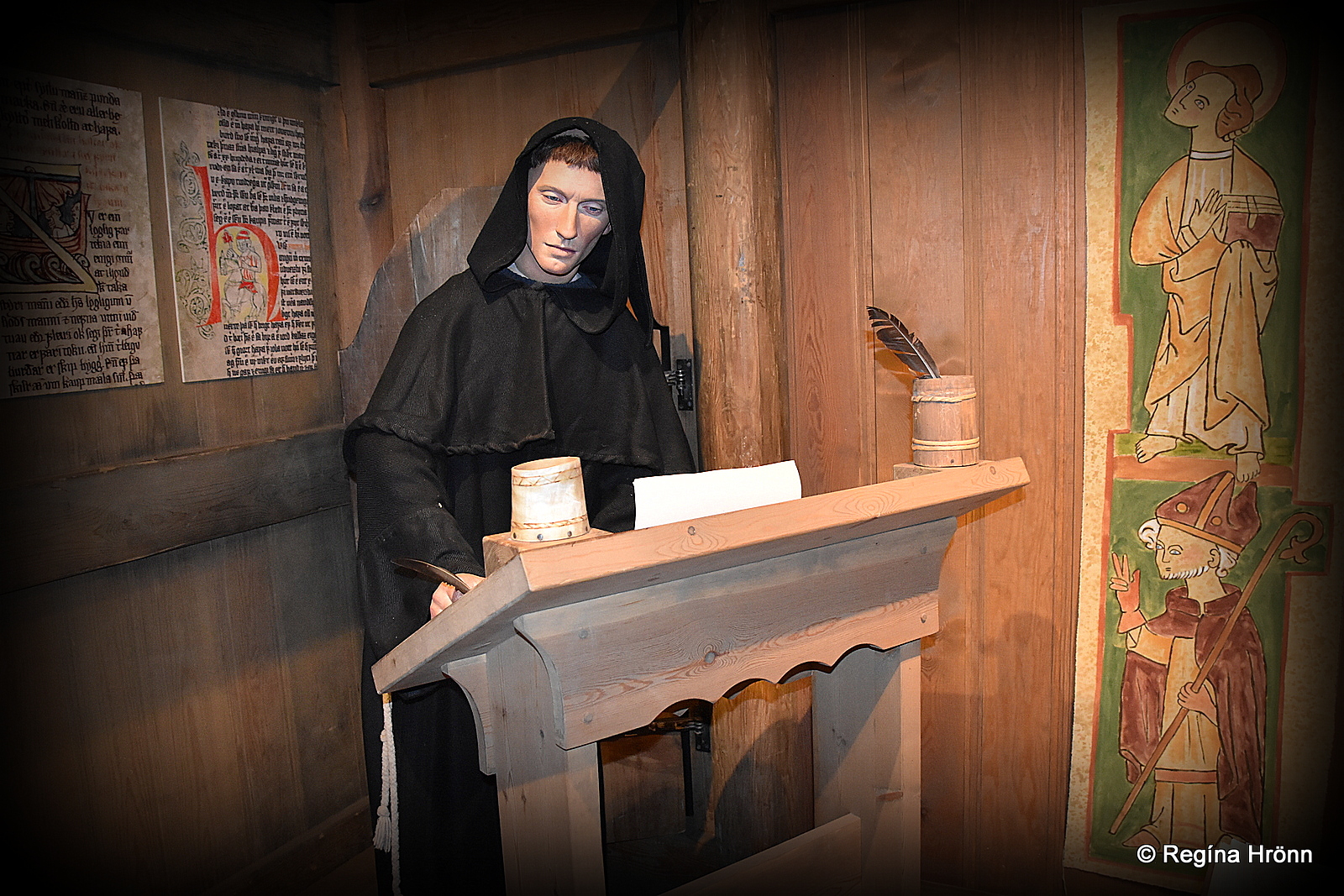
At the Saga Centre
The Árni Magnússon (1663-1730) Manuscript Collection is listed on the UNESCO list, the Memory of the World Register. UNESCO describes the Sagas as being “widely recognised as constituting one of the high points of world literature and still translated and read throughout the world today“.
It is not known exactly who wrote the Sagas, but it is believed that the noted Snorri Sturluson, wrote the Saga of Egill.
The Saga Centre – the Saga of Njáll

At the Saga Centre
By now it was time to dive head-first into Njálssaga – the Saga of Njáll, the Queen of the Icelandic Sagas. From Þjórsárdalur valley, Kjartan drove us straight to the Saga Centre, which offers an exhibition on the Saga of Njáll.
At the Saga Centre, you will get acquainted with the characters and main events in the epic Saga of Njáll.
At the Saga Centre, you will also learn about the Vikings and how they searched for new territories in their open Viking ships on the open Atlantic ocean. Some of them settled on this volcanic island way up north, where they lived and fought the elements and each other.
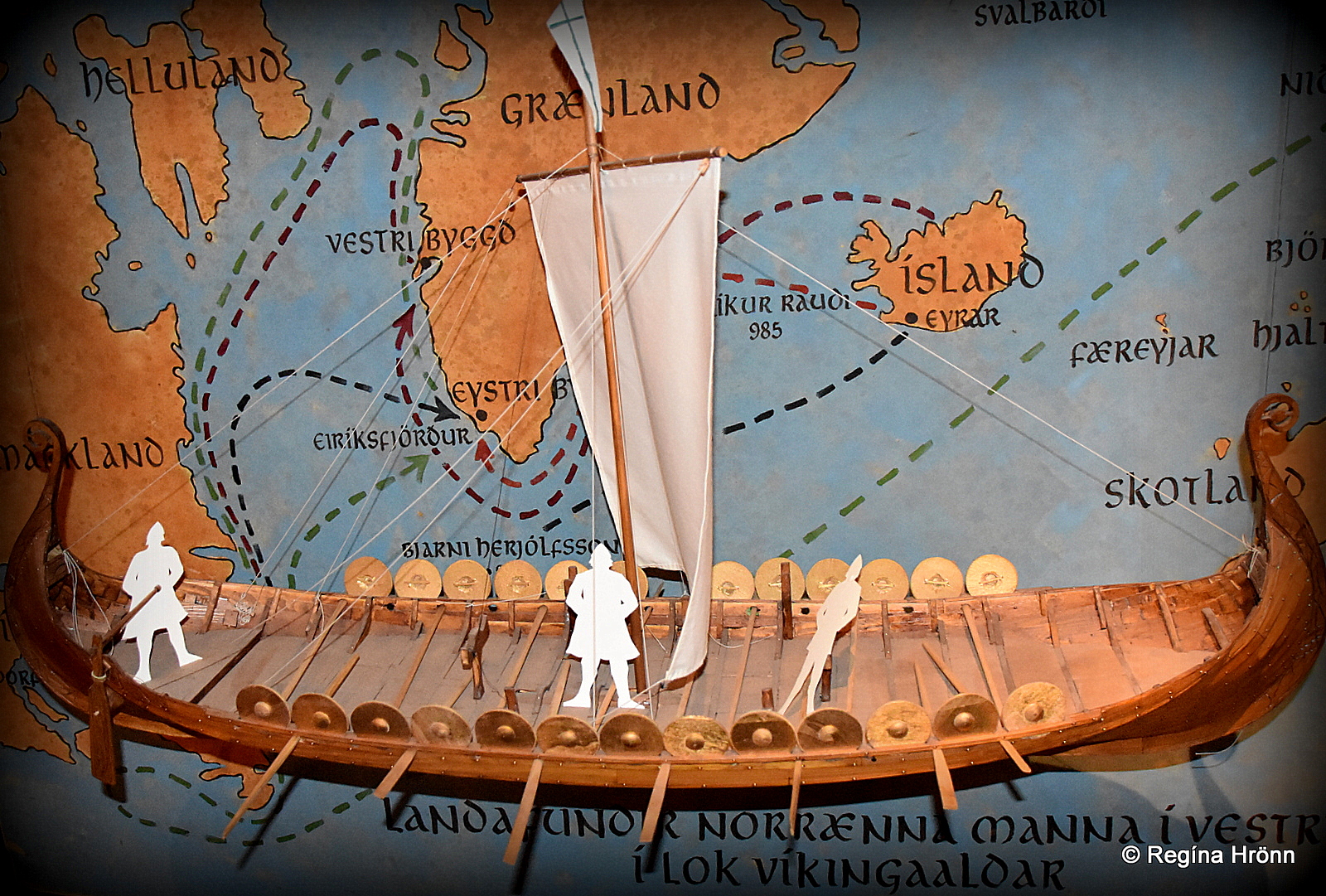
A Viking ship at the Saga Centre
Here they had to survive through harsh winters with drift ice and unexpected volcanic eruptions, but they persevered and most of us, who still live here in Iceland, are direct descendants of the Vikings.
Kjartan and I are direct descendants of the Vikings, and both the name Kjartan and the name of my father, Ragnar, are old Viking names. Kjartan and I found out on this tour that we are also related; we are third cousins.
The Vikings were looking for a safer place to live and to raise their families, but feuds and battles were to take place on this former peaceful island, where only a few Irish monks seem to have lived before the Vikings arrived.
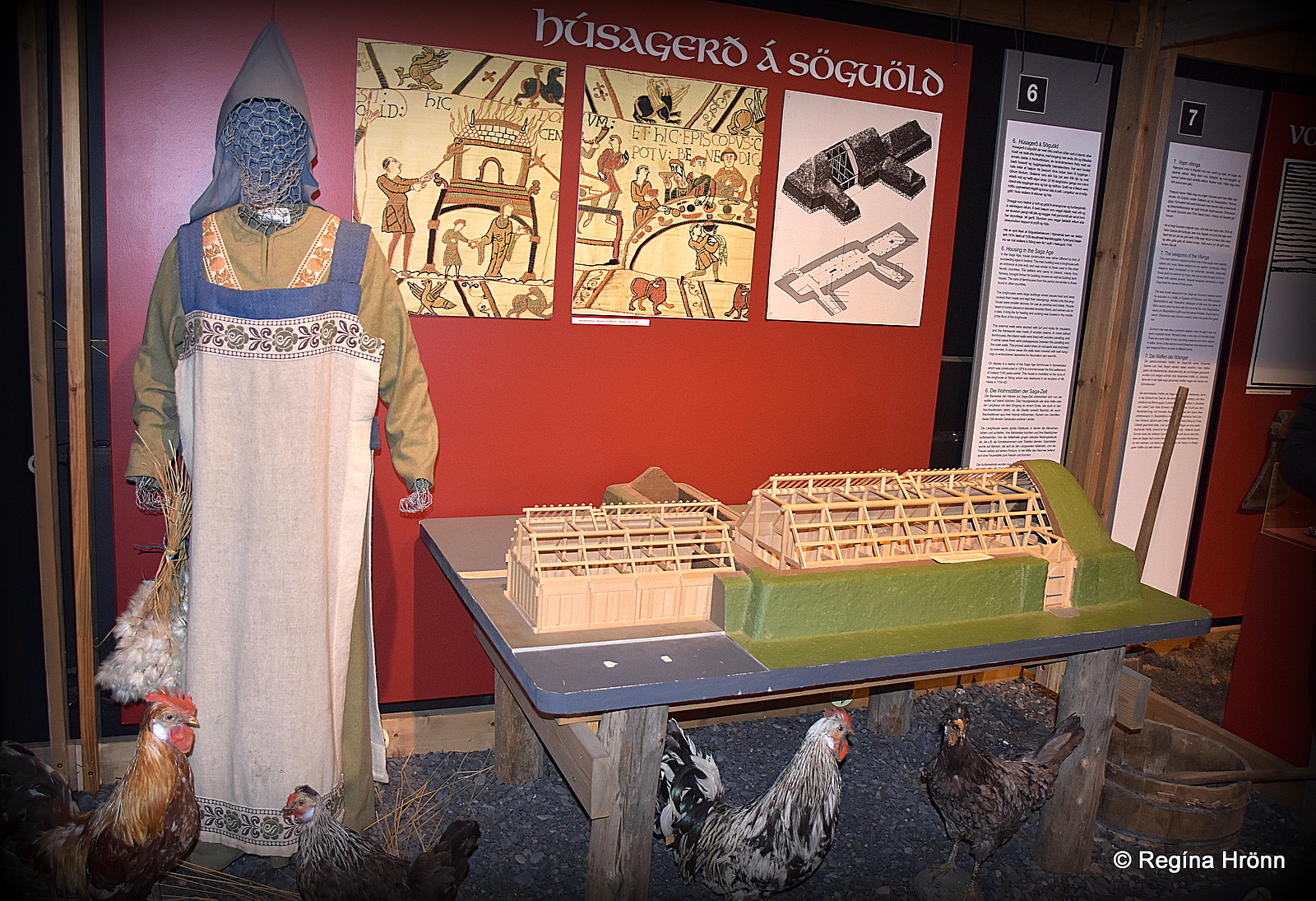
At the Saga Centre
The Saga of Njáll is the longest one of the Icelandic Viking Sagas and one of the best known of the Sagas. It took place around the turn of the millennium in 1,000 in South-Iceland.
It tells the story of 2 good friends, the Vikings Gunnar and Njáll, and their families. Their wives were enemies and quite cruel.
It doesn’t end well for them as Gunnar got killed by his enemies and Njáll got burned to death in his home, Bergþórshvoll, together with his wife, 2 sons and grandson. And his 3rd son, Helgi, got killed as he tried to leave Bergþórshvoll.
The Saga of Njáll tells you the story of a power struggle, a battle, strong love, and deceit. It is one of my favourite Sagas.
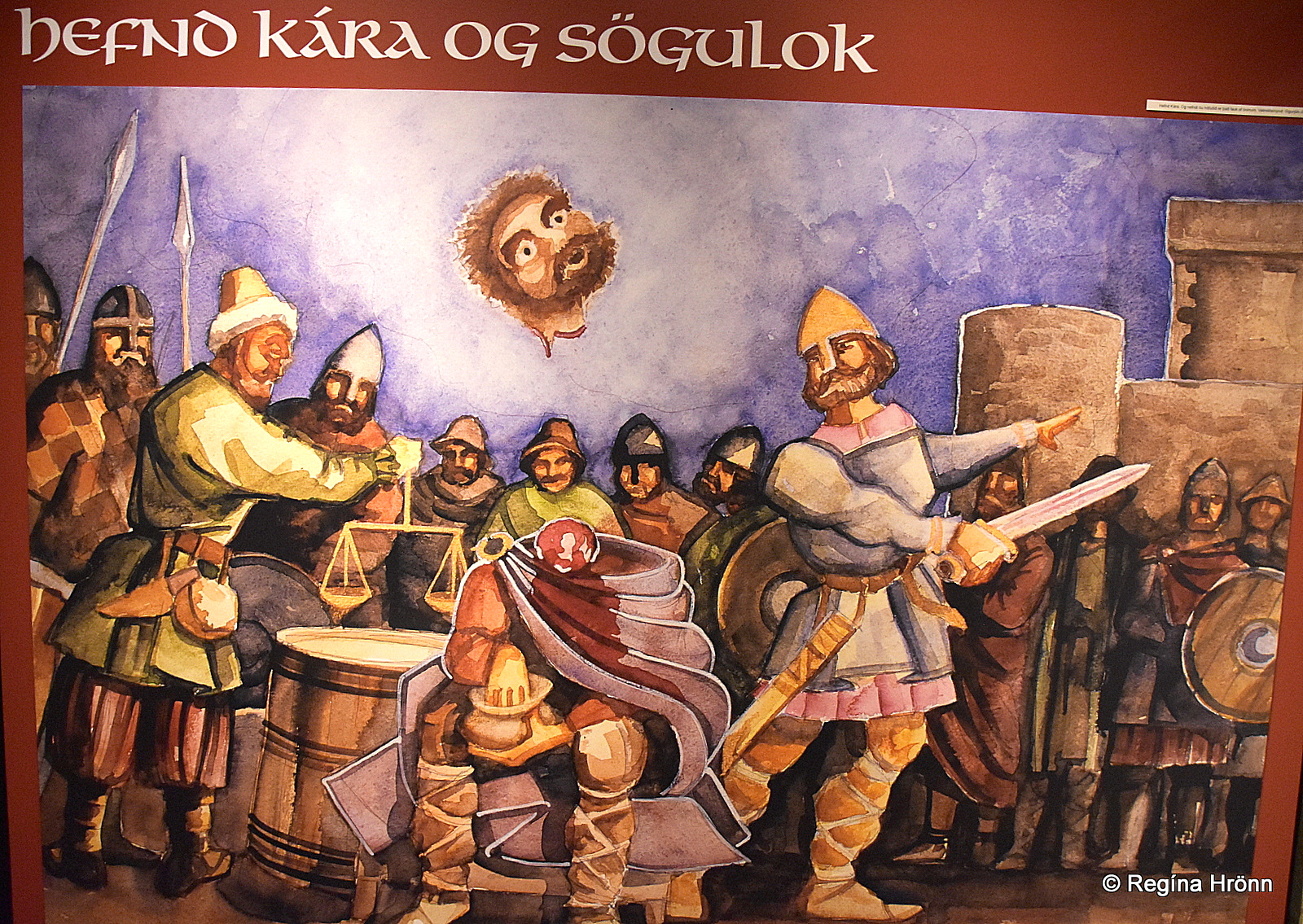
The revenge of Kári
The Saga of Njáll took place in South-Iceland – in the Rangárþing region to be more exact.
The exhibition at the Saga Centre contains paintings, some very graphic Viking style paintings like the one above, with text about the Saga of Njáll.
You will spend some 30 minutes at the exhibition and it is a lot to take in, so better come prepared. It is best to read up on this subject before joining the tour to get the most out of your visit to the Saga Centre.
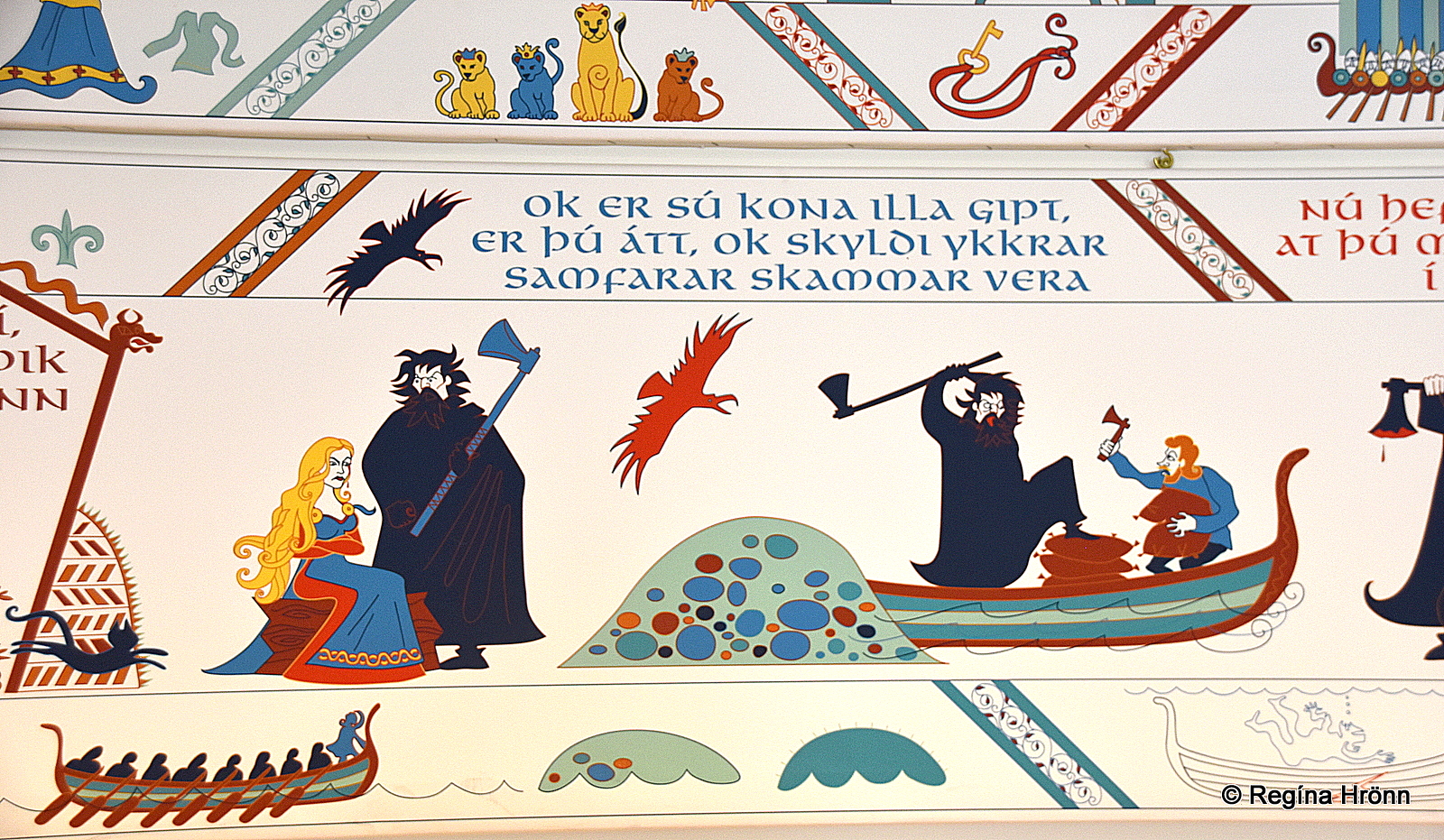
The prototype for the Njáll tapestry
Many people have read the Saga of Njáll, which I, of course, recommend doing, but you can also read the retold Saga of Njáll with illustrations, which I always find to be helpful to remember events from the Sagas.
You can also flick through the Icelandic Sagas online in English, Icelandic, Old Norse and several other languages.
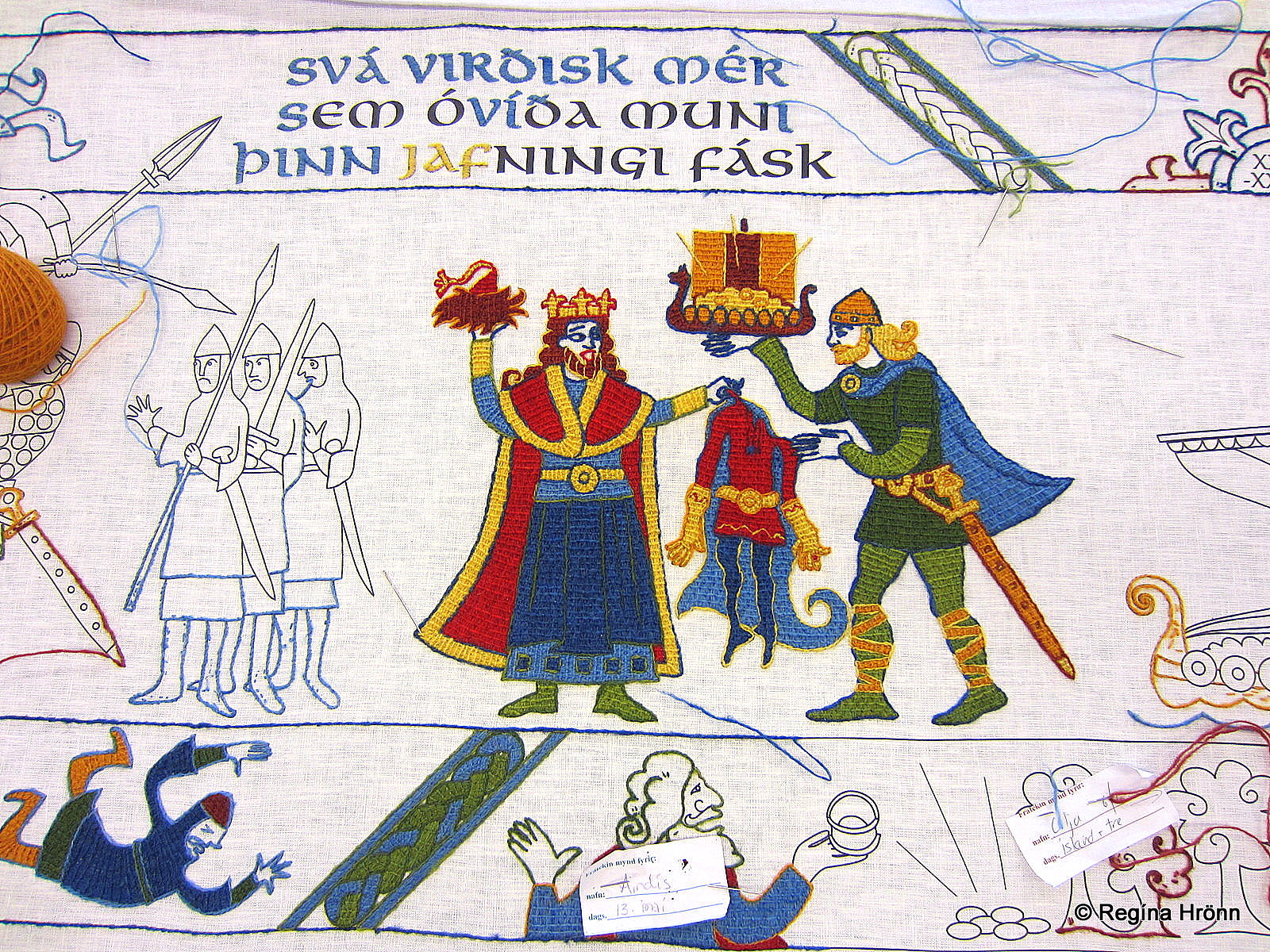
Njálurefill – the Njáll tapestry
At the Saga Centre, you will also find Njálurefill – the Njáll tapestry – where the main events of the Saga of Njáll are sown in a 90-metre long tapestry. The stitch used is called “refilsaumur” stitching (Bayeux stitch), a stitch that was used in the Viking age.
You can have a look at the prototype at the Saga Centre. The first photo above is of one part of the prototype and the second photo is of the Njáll tapestry itself.
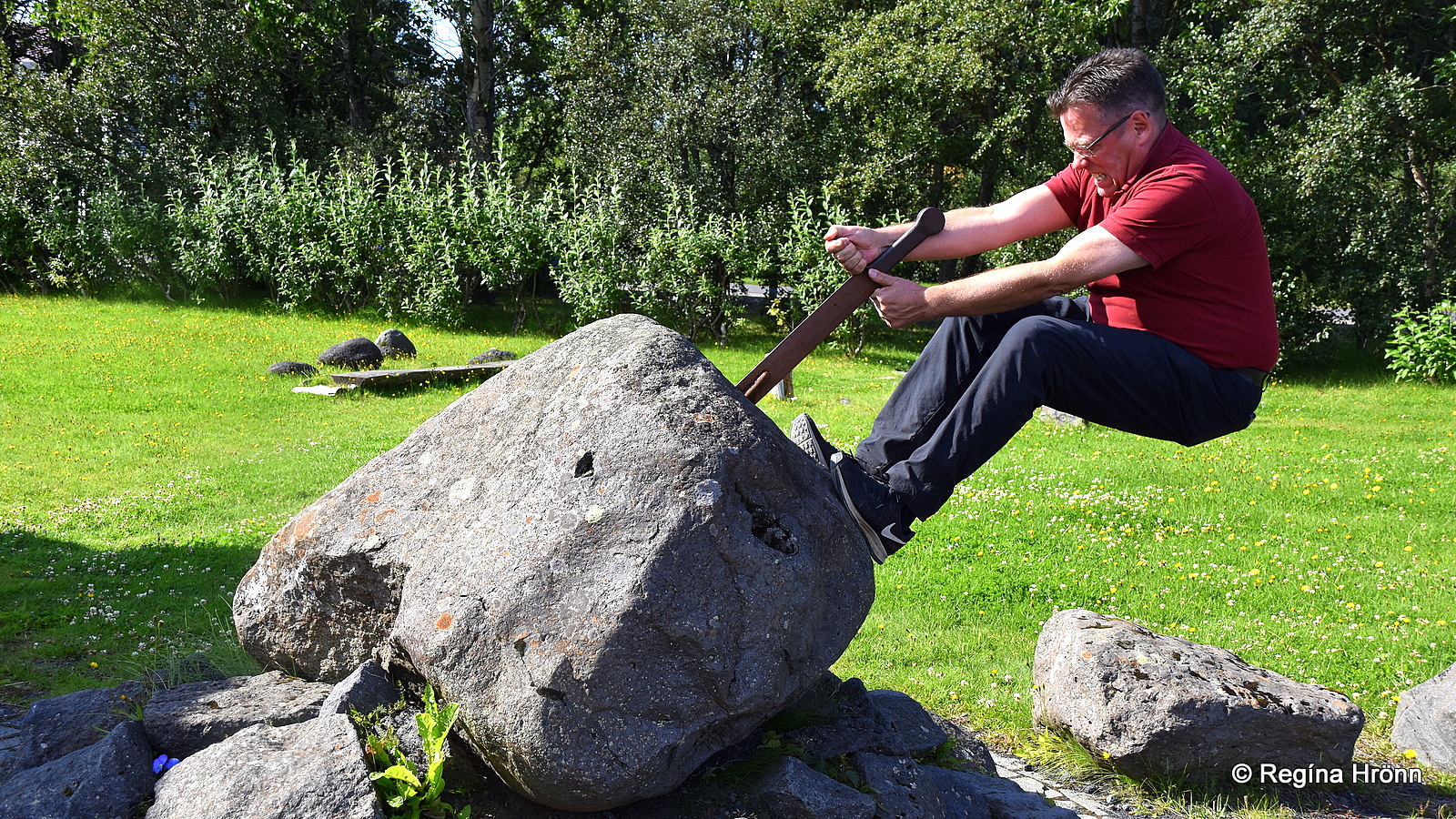
Kjartan trying to pull out the sword
Outside the Saga Centre, you can try your strength; Kjartan tried to pull out the sword with all his might. Even if you don’t manage to pull the sword out of the rock, Excalibur style, then it makes for a good photo 🙂
I love such Viking exhibitions and always seek them out on my travels in my country and abroad.
Hlíðarendi – the home of Gunnar
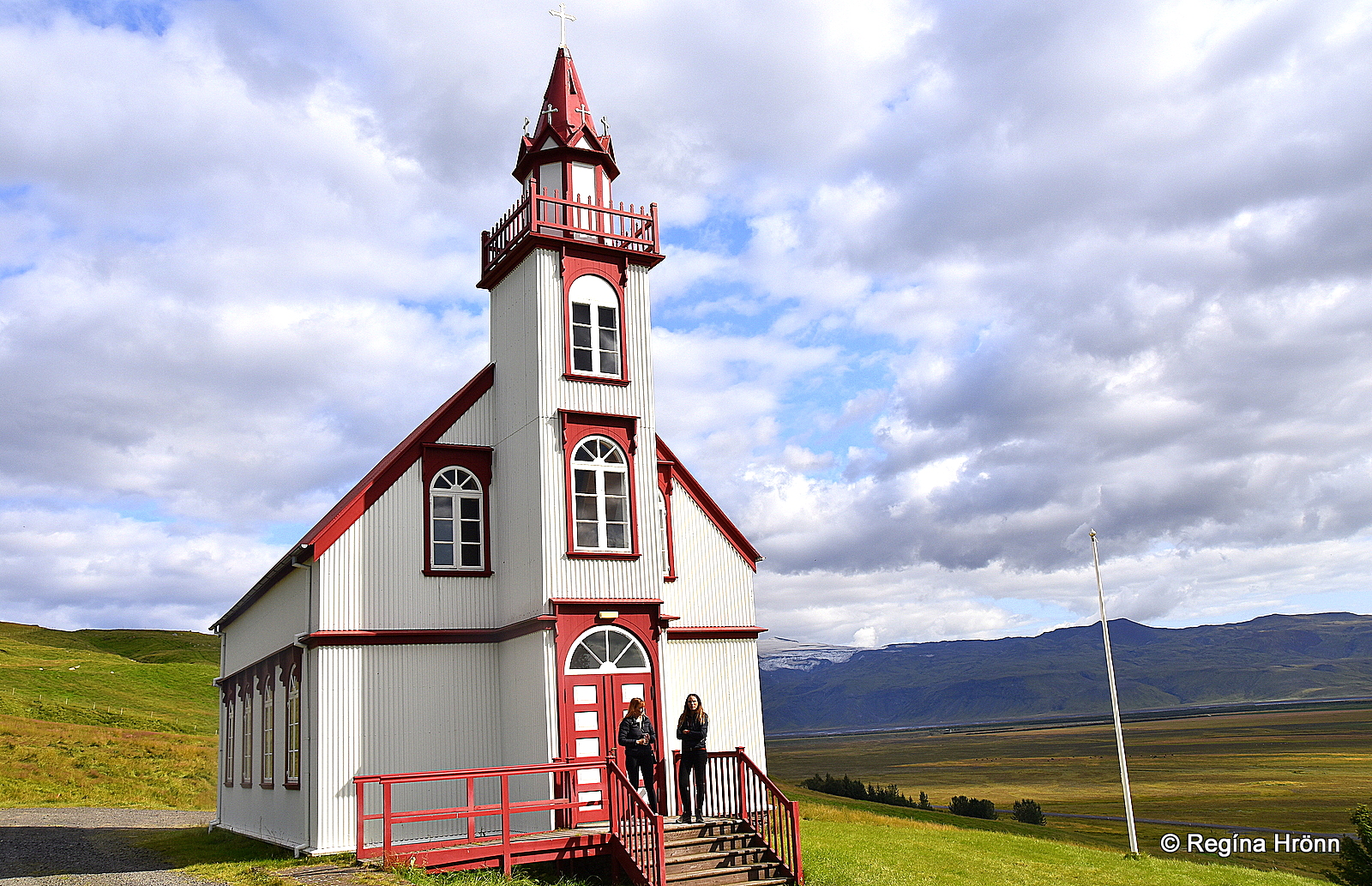
Hlíðarendakirkja church
Next, we visited Hlíðarendi, the home of Gunnar Hámundarson and his wife Hallgerður “langbrók” Höskuldsdóttir, two of the main characters of the Saga of Njáll.
Gunnar was born in around 940 and died in around 992. Gunnar and Hallgerður had 2 sons, Högni and Grani.
Gunnar at Hlíðarendi, as we call him when we refer to him, was one of the great warriors of his time, and it is written in the Sagas that nobody was his equal. He is described as being so agile that he could jump his own height in a full suit of armour!

Hlíðarendakirkja church
At Hlíðarendi you will find a beautiful church from where there is a great view of the surrounding area.
Here the guide will tell you stories about the Viking Gunnar. Gunnar is described as being quite handsome, with fair hair, blue eyes, and a straight nose. He was generous, polite and popular.
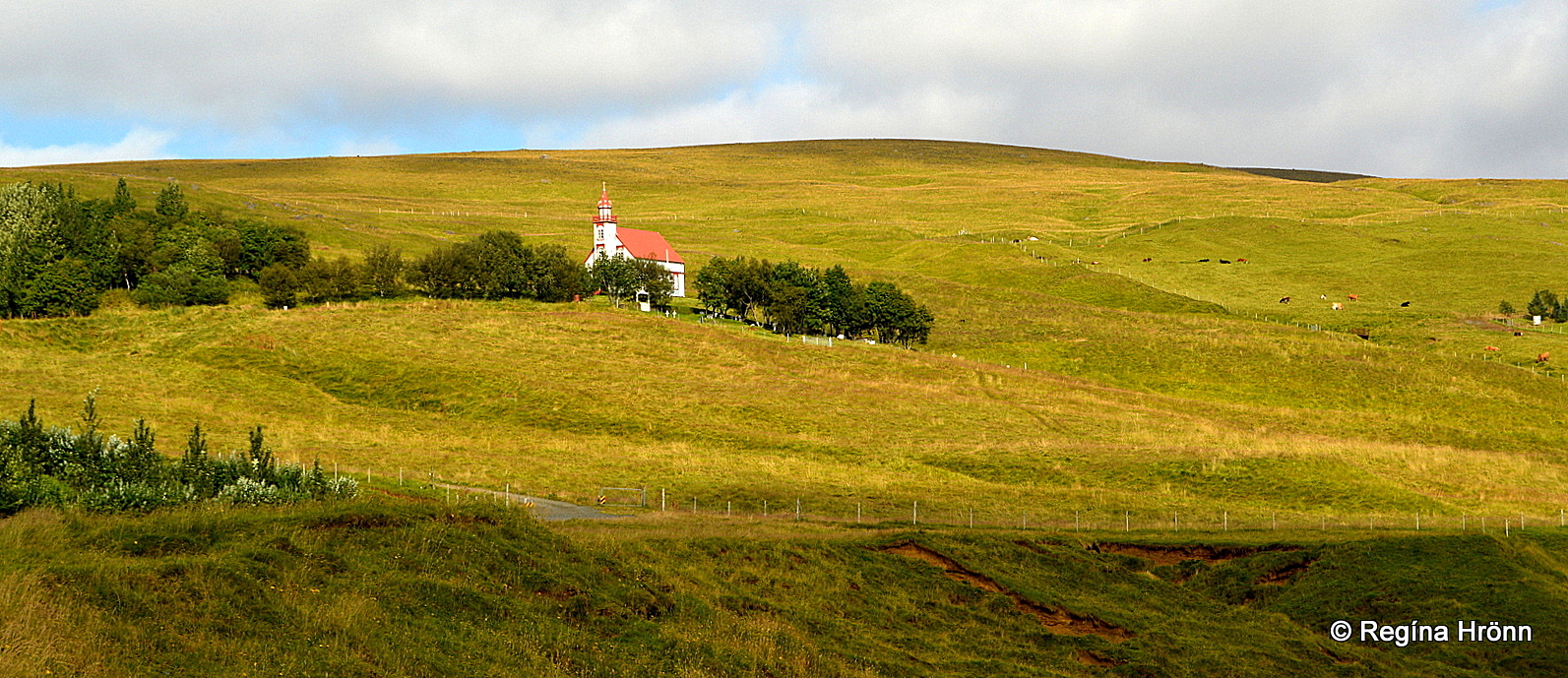 Hlíðarendi
Hlíðarendi
Gunnar was killed here at Hlíðarendi and buried in a grave mound. He chose the fate of dying in an honourable fight rather than leaving Iceland as an outlaw.
The Saga tells us that when he had been sentenced to exile and was riding to the ship to take him away from his home, his horse tripped.
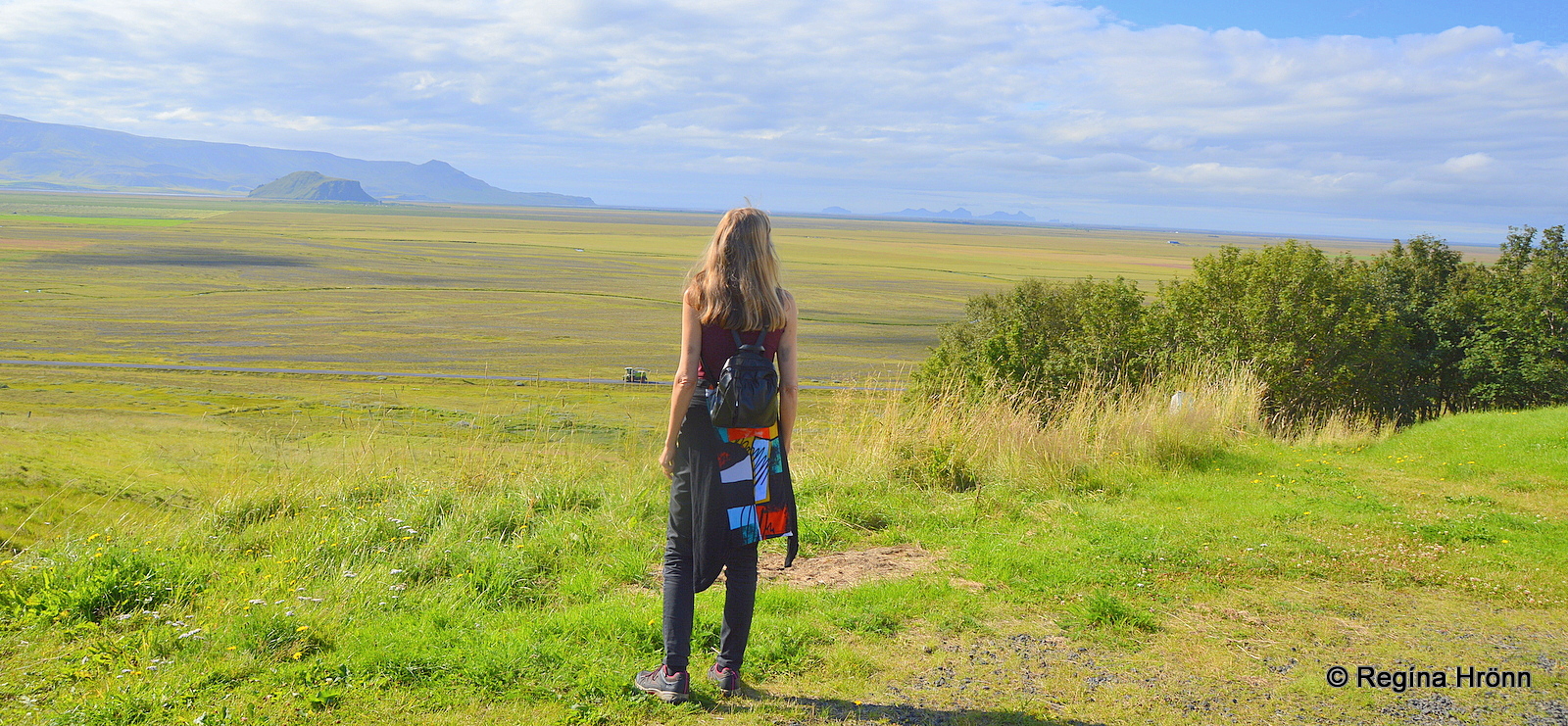
The beautiful view from Hlíðarendi
Gunnar stopped and looked back at his home, and said:
“Fögur er hlíðin svo að mér hefir hún aldrei jafnfögur sýnst, bleikir akrar en slegin tún og mun eg ríða heim aftur og fara hvergi.”
– meaning that because of the beauty of the hill, which to him had never looked as beautiful with its fertile fields and newly cut hayfields, he would ride back home and stay in this beautiful place.
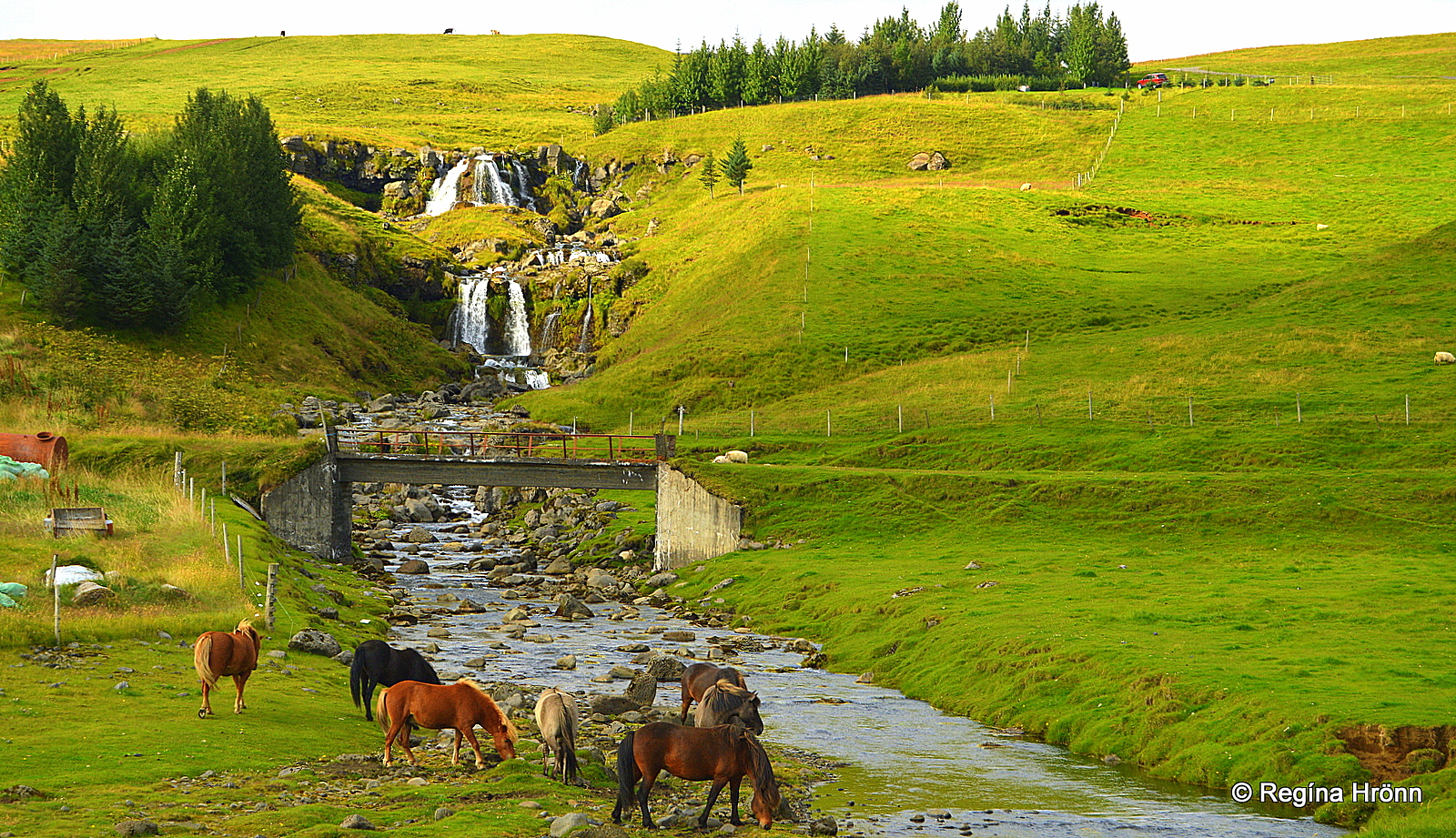
Horses and a waterfall by Hlíðarendi
Here is a well-known incident from the Saga of Njáll just to show you how strong the women were in the Sagas: Gunnar had slapped his wife Hallgerður “langbrók” in the face earlier in the Saga and she had told him that she would not forget this slap.
So when Gunnar, who was a renowned archer, needed a new bowstring for his bow in a life-threatening situation, he asked his wife for a lock of her long hair to use as a bowstring, so he could defend himself against his enemies.
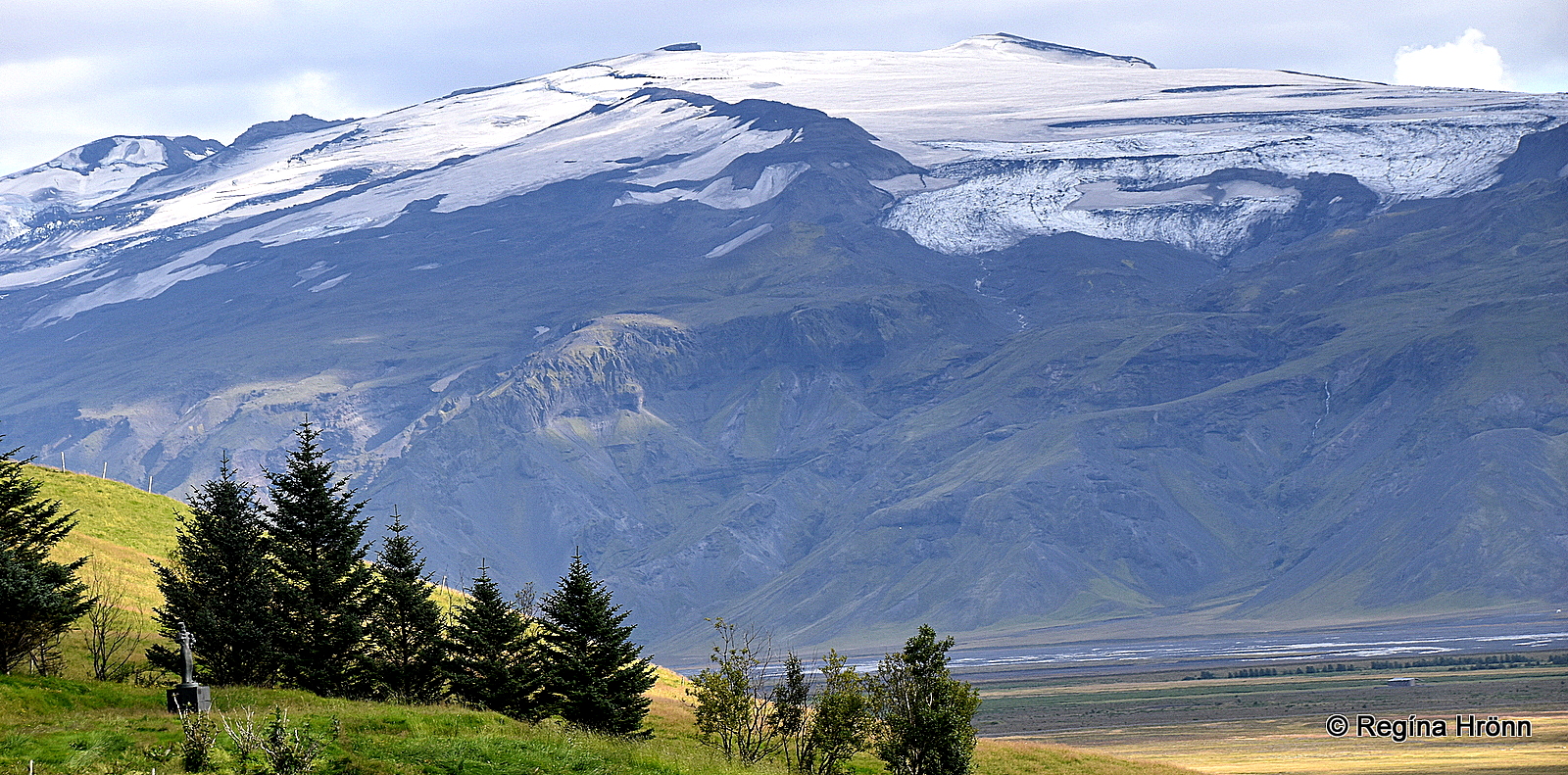
Eyjafjallajökull glacier as seen from Hlíðarendi
Hallgerður had not forgotten the slap she got from Gunnar and refused to give a lock of her hair to her husband – thus contributing to his death!
There is a fantastic view from Hlíðarendi and here we are in the vicinity of another active volcano!
That is the Eyjafjallajökull glacier and volcano which erupted back in 2010 and caused havoc all around the world as the ashes spewing from it stopped air traffic. See how close we are to the volcano!
If you walk up the hill above the church you will see this information sign about Gunnar at Hlíðarendi.
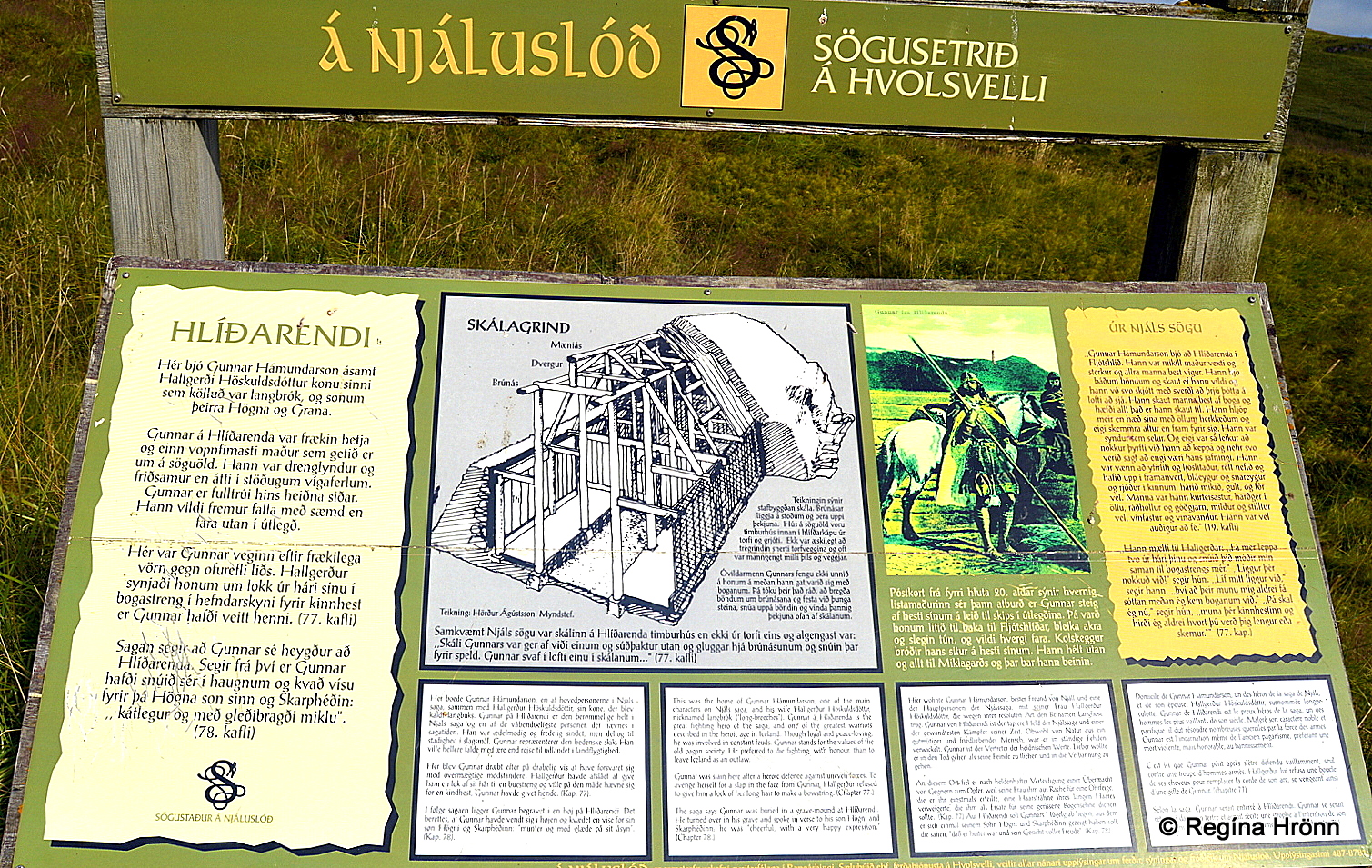
The information sign at Hlíðarendi
What I would love to see at Hlíðarendi, this historic place, is a memorial for Gunnar, maybe a statue of this great warrior from the Icelandic Sagas.
We Icelanders are sometimes slow in recognizing the importance of our Viking inheritance. That is why I cheered when I finally saw a guided tour of Viking locations and asked Kjartan if I could join the tour and write about it.
Bergþórshvoll – the home of Njáll
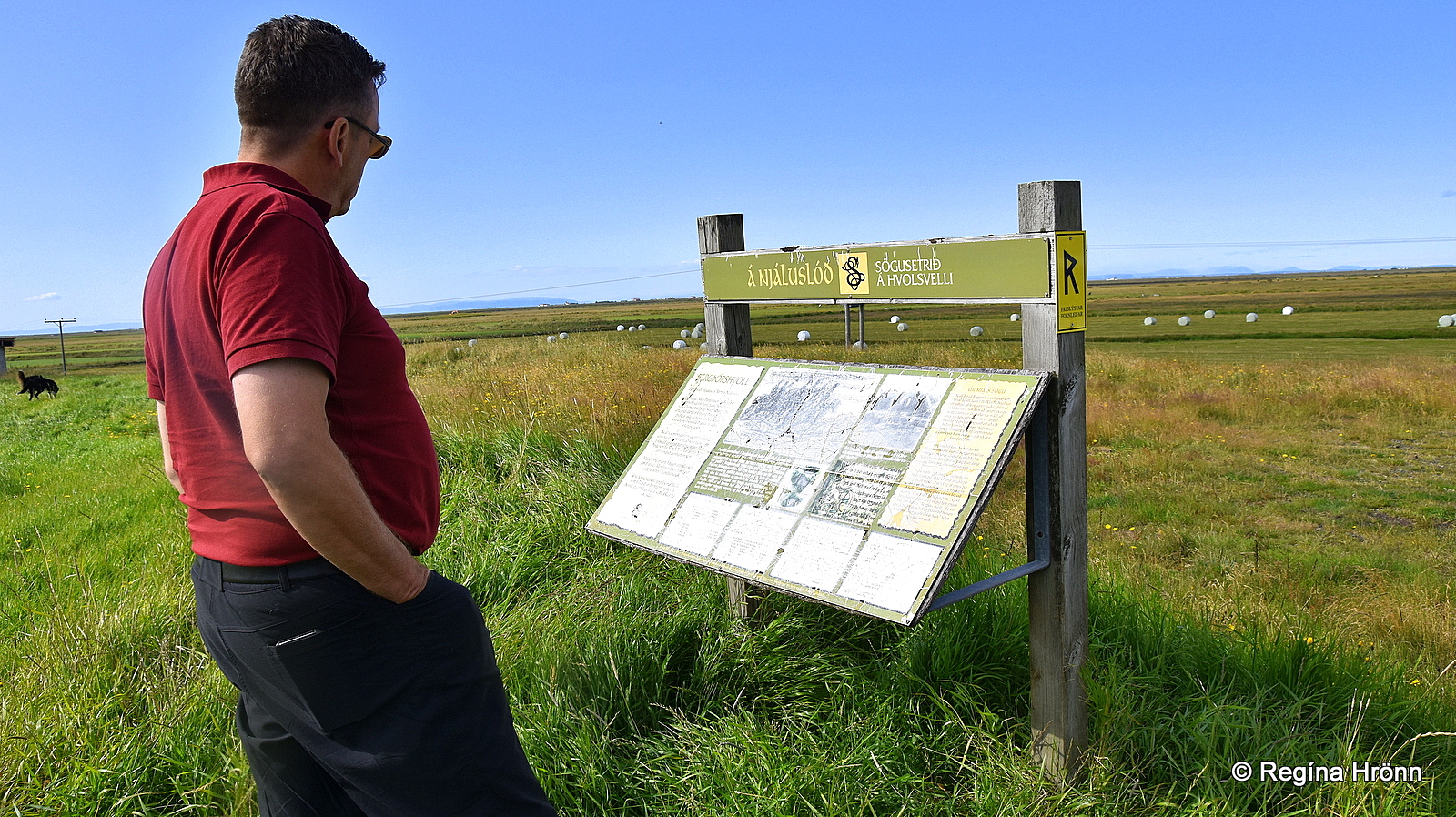
Kjartan by the information sign at Bergþórshvoll
Our next stop was at Bergþórshvoll in Vestur-Landeyjar, the former home of the other main character of the Saga of Njáll, Gunnar’s best friend, Njáll at Bergþórshvoll. Njáll Þorgeirsson was born around 930 and died in the fire of Bergþórshvoll around 1010.
This is how Njáll was described in the Saga of Njáll: Njáll was wise and foresighted, gave good advice, he was humble and generous. And he solved the problems of the men seeking his help.
His sons, on the other hand, were feisty and gained many enemies.
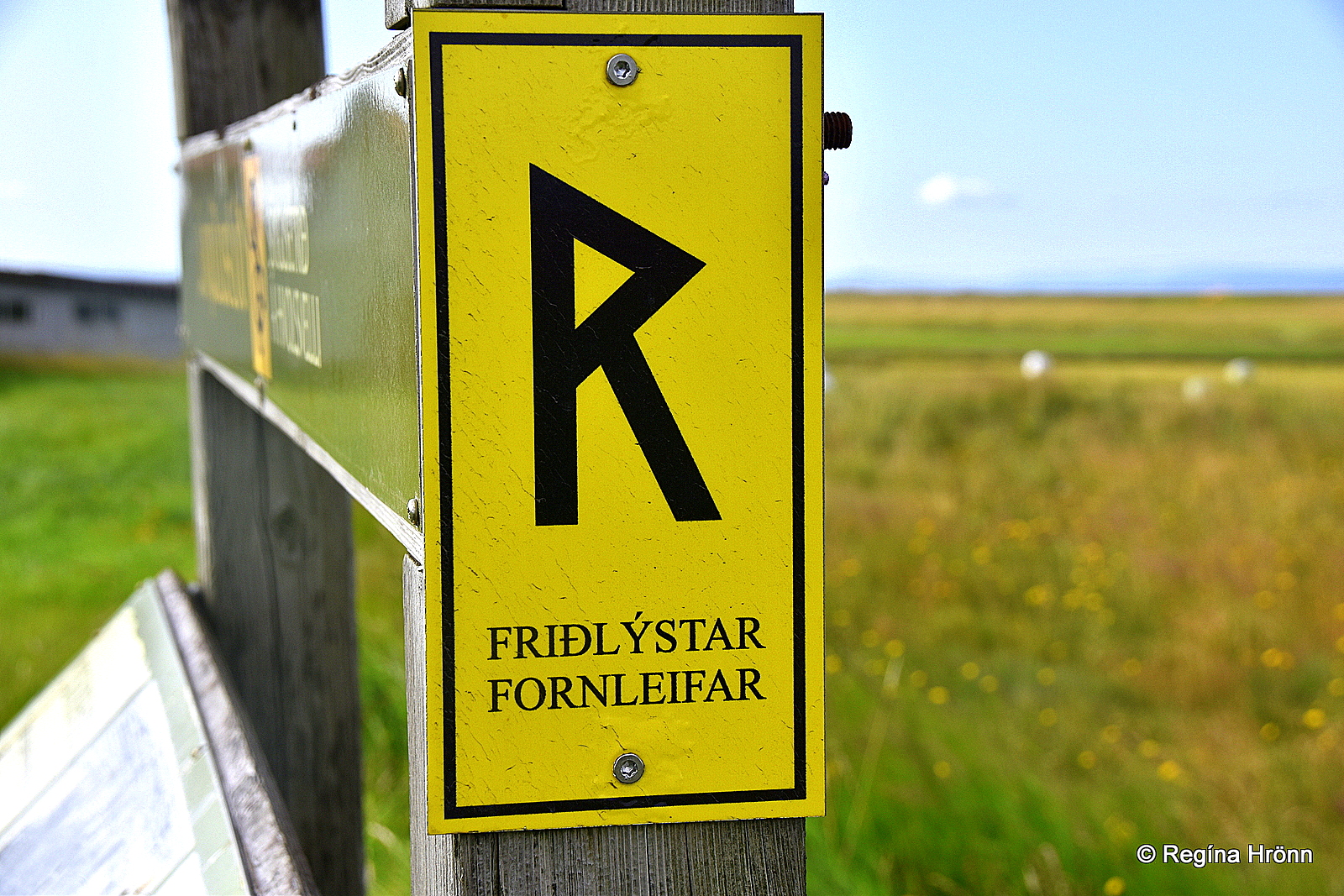
Friðlýstar fornleifar – preserved antiquities at Bergþórshvoll
As I mentioned earlier, Njáll and his wife, 2 of their sons, Skarphéðinn and Grímur, and a grandson were burned to death at Bergþórshvoll, that is why the name of this Saga is The Saga of Burnt Njáll. At Bergþórshvoll our guide told us about the fire and the sad fate of Njáll and his family.
I have only touched the surface of the Sagas in my travel-blog, but the expert guide will tell you much more and get into details about the Saga of Njáll.
Archaeological excavations have taken place at Berþórshvoll to search for burnt ruins of the old Viking farm. But seeing that the farm has most likely always been built on the same spot, then they didn’t find any burnt ruins of a Viking longhouse. Burnt ruins of outhouses were excavated, which might be the outhouses of Njáll.
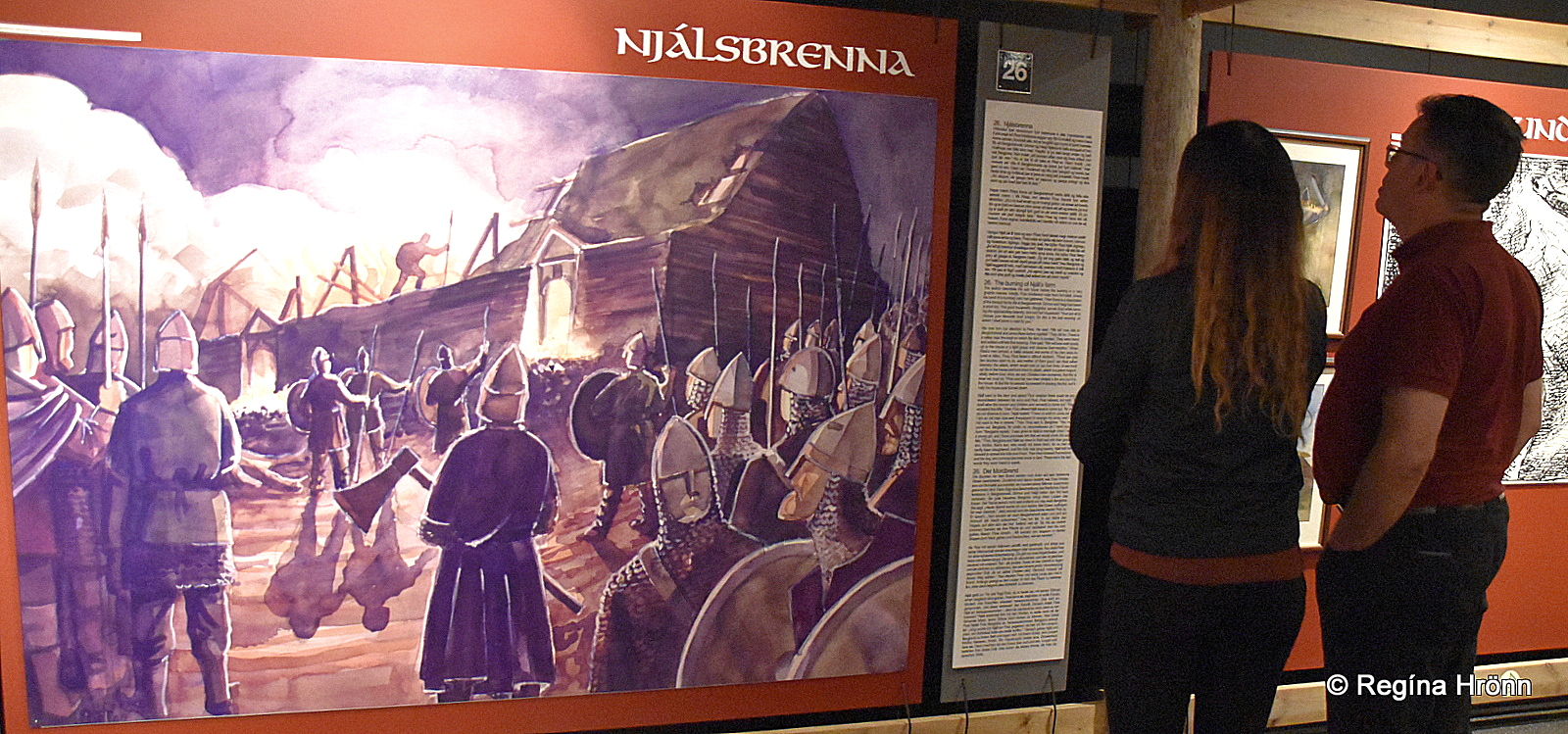
At the Saga Centre in Hvolsvöllur – reading about the Njálsbrenna fire
Bergþórshvoll was our last stop on this tour before dinner. This beautiful day ended in my favourite restaurant in Iceland, Fjörukráin at the Viking Village, which is a fitting restaurant for a Vikings and Sagas tour.
I am such a great fan of the Viking Village that I take all my foreign guests there. I love the Viking theme at the Viking Village and it always makes me feel like I stepped back in time.
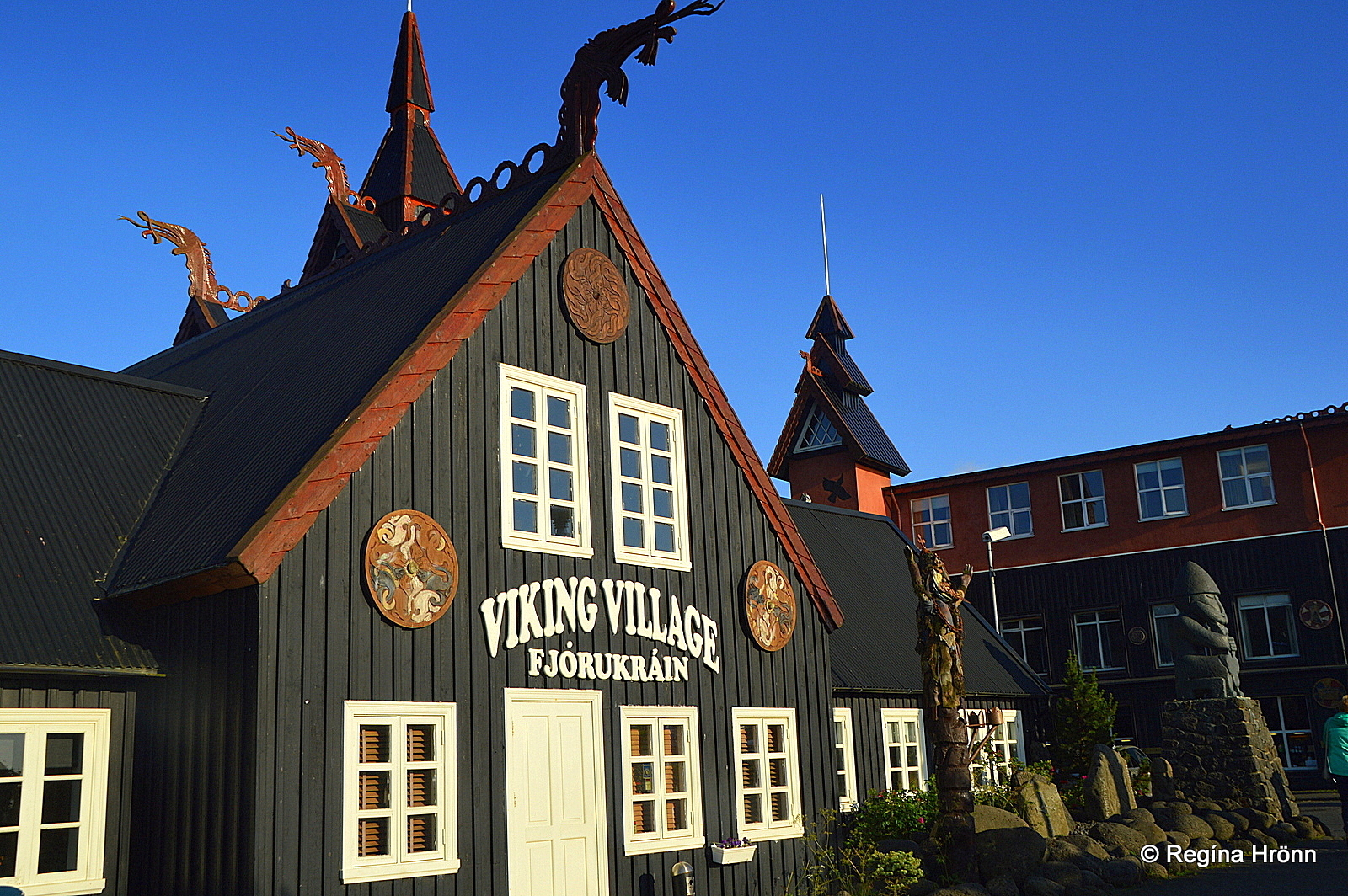
Fjörukráin at the Viking Village
Fjörukráin restaurant at the Viking Village is located in the second oldest house (1841) in Hafnarfjörður town, also referred to as the Viking Town and the Town of the Elves.
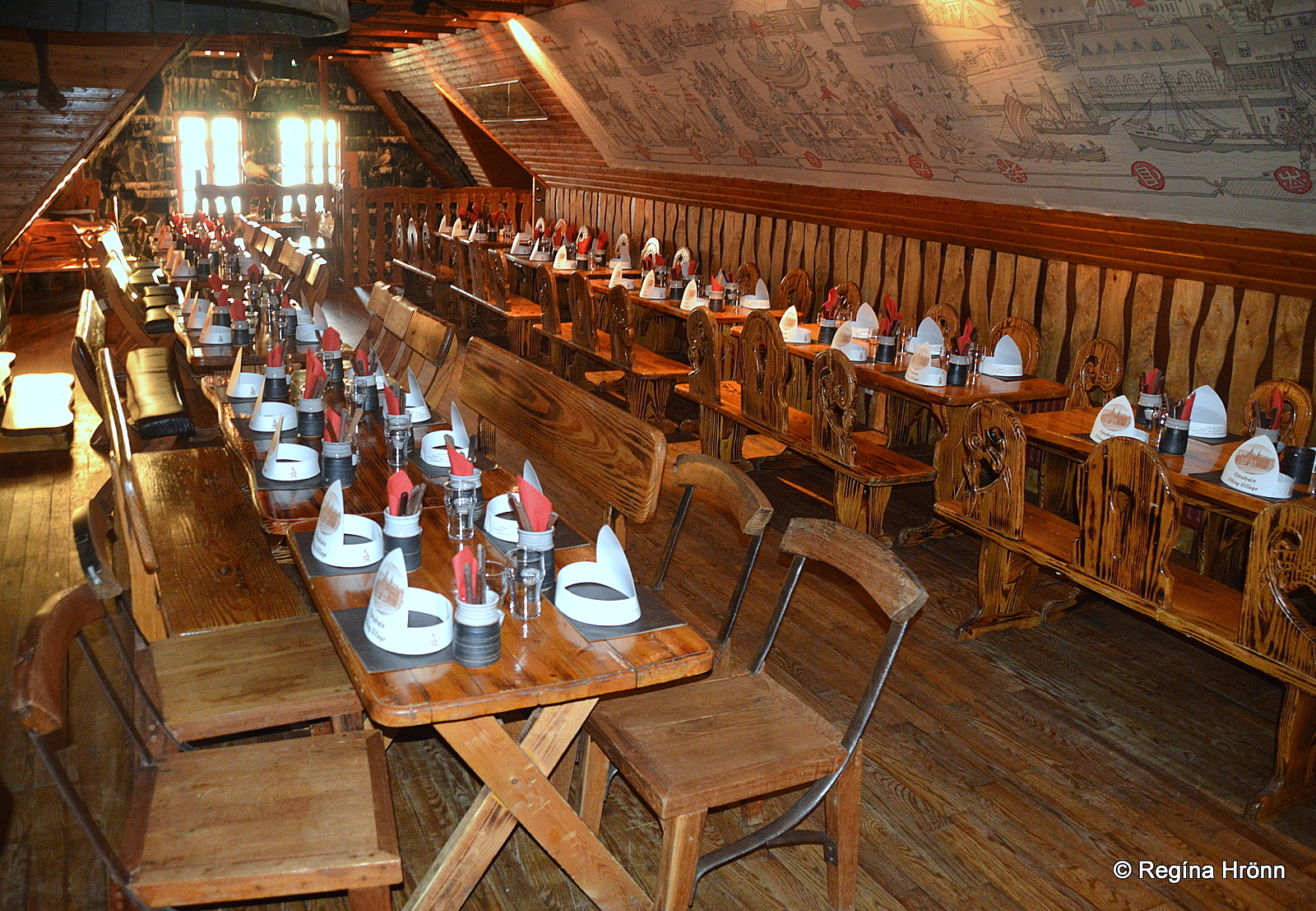
Fjörukráin restaurant at the Viking village
You can ask your guide to take you on a tour of the premises and check out the upper floors; the whole restaurant is very ornate and there is a lot to see and photograph.
The staff is dressed up in Viking clothes and often there is live music when troubadours walk from table to table and sing the most beautiful Icelandic songs. I love that part of the evening at the Viking Village 🙂
A fantastic 12-hour tour was drawing to an end and after dinner, our driver/guide drove back to the hotel and returned me to my home. I was very happy with this tour and can highly recommend it 🙂
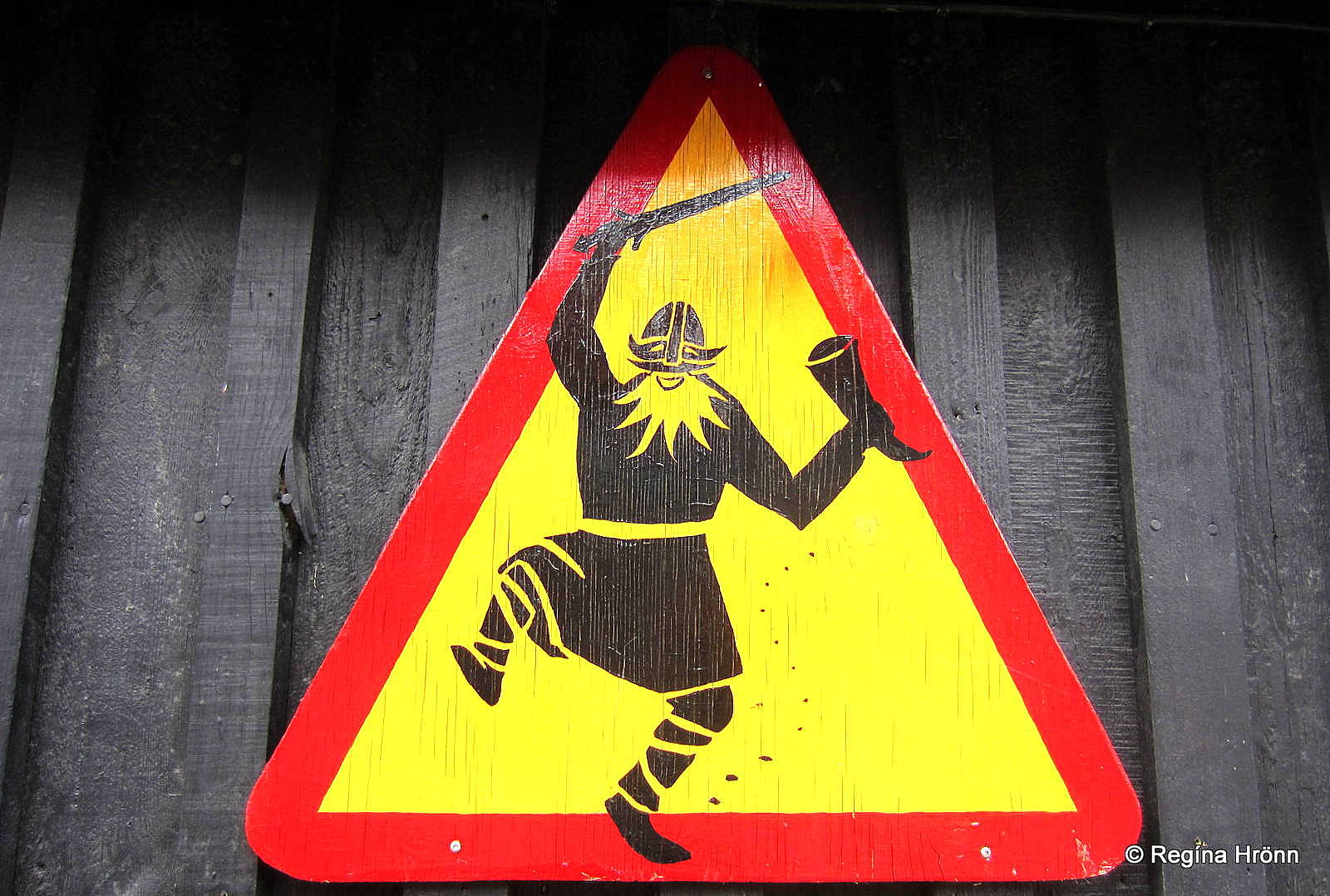
The Drunken Viking sign at the Viking Village
Have a lovely time on The Vikings & the Sagas / A Tour Through History – it is truly a one of a kind tour 🙂
